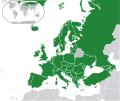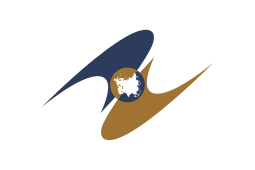Russia
Russia (Russian: Росси́я, tr. Rossiya, IPA: [rɐˈsʲijə]), or the Russian Federation,[15][lower-alpha 4] is a transcontinental country stretching from Central Europe[lower-alpha 5] to Northern Asia.[16] With a land area of 17,125,200 square kilometres (6,612,100 sq mi),[17] it is the largest country in the world by area, covering more than one-eighth of the Earth's inhabited land area,[18][19] spanning eleven time zones, and bordering 16 sovereign nations. The territory of Russia extends from the Baltic Sea in the west to the Pacific Ocean in the east, and from the Arctic Ocean in the north to the Black Sea and the Caucasus in the south. With 146.7 million inhabitants living in the country's 85 federal subjects,[11] Russia is the most populous nation in Europe and the ninth-most populous nation in the world.[20][21] Russia's capital and largest city is Moscow; other major urban areas include Saint Petersburg, Novosibirsk, Yekaterinburg, Nizhny Novgorod, Kazan, Chelyabinsk and Samara.
Russian Federation
| |
|---|---|
_-_only_Crimea_disputed.svg.png) Location of Russia with Crimea in light green[lower-alpha 2] | |
| Capital and largest city | Moscow 55°45′N 37°37′E |
| Official language and national language | Russian |
| Recognised national languages | See Languages of Russia |
| Ethnic groups (2010)[5] | |
| Religion (2017)[6] | 74% Christianity —71% Russian Orthodoxy —3% Other Christian 15% No religion 10% Islam 1% Other religions |
| Demonym(s) | Russian |
| Government | Federal dominant-party semi-presidential constitutional republic[7] |
| Vladimir Putin | |
| Mikhail Mishustin | |
| Valentina Matviyenko | |
| Vyacheslav Volodin | |
| Vyacheslav Lebedev | |
| Legislature | Federal Assembly |
| Federation Council | |
| State Duma | |
| Formation | |
| c. 862 | |
| 879 | |
| 1283 | |
| 16 January 1547 | |
| 22 October 1721 | |
| 15 March 1917 | |
| 8 December 1991 | |
| 12 December 1993 | |
| 18 March 2014 | |
| 4 July 2020 | |
| Area | |
• Total | 17,098,246 km2 (6,601,670 sq mi)[8] (without Crimea)[lower-alpha 3] (1st) |
• Water (%) | 13[10] (including swamps) |
| Population | |
• 2020 estimate | (9th) |
• Density | 8.4/km2 (21.8/sq mi) (225th) |
| GDP (PPP) | 2020 estimate |
• Total | |
• Per capita | |
| GDP (nominal) | 2020 estimate |
• Total | |
• Per capita | |
| Gini (2018) | medium · 98th |
| HDI (2018) | very high · 49th |
| Currency | Russian ruble (₽) (RUB) |
| Time zone | UTC+2 to +12 |
| Date format | dd.mm.yyyy |
| Driving side | right |
| Calling code | +7 |
| ISO 3166 code | RU |
| Internet TLD | |
The East Slavs emerged as a recognisable group in Europe between the 3rd and 8th centuries AD.[22] The medieval state of Rus' arose in the 9th century. In 988 it adopted Orthodox Christianity from the Byzantine Empire, beginning the synthesis of Byzantine and Slavic cultures that defined Russian culture for the next millennium.[23] Rus' ultimately disintegrated into a number of smaller states,[24] until it was finally reunified by the Grand Duchy of Moscow in the 15th century. By the 18th century, the nation had greatly expanded through conquest, annexation, and exploration to become the Russian Empire, which became a major European power, and the third-largest empire in history, stretching from Norway on the west to Canada on the east.[25][26] Following the Russian Revolution, the Russian SFSR became the largest and leading constituent of the Soviet Union, the world's first constitutionally socialist state.[27] The Soviet Union played a decisive role in the Allied victory in World War II,[28][29] and emerged as a recognised superpower and rival to the United States during the Cold War. The Soviet era saw some of the most significant technological achievements of the 20th century, including the world's first human-made satellite and the launching of the first humans in space. Following the dissolution of the Soviet Union in 1991, the Russian SFSR reconstituted itself as the Russian Federation and is recognised as the continuing legal personality and a successor of the USSR.[30]
Following the constitutional crisis of 1993, a new constitution was adopted and Russia has been governed as a federal semi-presidential republic.[7] Vladimir Putin became acting president on 31 December 1999 after Boris Yeltsin resigned and was elected president in March 2000. Since then, he has dominated Russia's political system as either president or prime minister.[31] His government has been accused by non-governmental organisations of numerous human rights abuses, authoritarianism and corruption. In response, Putin has argued that Western-style liberalism is obsolete in Russia, while maintaining that the country is still a democratic nation.[32][33][34]
The Russian economy ranks as the fifth-largest in Europe, the eleventh-largest in the world by nominal GDP and the fifth-largest by PPP.[35] Russia's extensive mineral and energy resources are the largest such reserves in the world,[36] making it one of the leading producers of oil and natural gas globally.[37][38] The country is one of the five recognised nuclear weapons states and possesses the largest stockpile of nuclear warheads.[39] Russia is a major great power, as well as a regional power, and has been characterised as a potential superpower. The Russian Armed Forces have been ranked as the world's second most powerful, and the most powerful in Europe. Russia hosts the world's ninth-greatest number of UNESCO World Heritage Sites, at 29,[40] and is among the world's most popular tourist destinations.[41] It is a permanent member of the United Nations Security Council and an active global partner of ASEAN,[42][43][44] as well as a member of the Shanghai Cooperation Organisation (SCO), the G20, the Council of Europe, the Asia-Pacific Economic Cooperation (APEC), the Organization for Security and Co-operation in Europe (OSCE), the International Investment Bank (IIB) and the World Trade Organization (WTO), as well as being the leading member of the Commonwealth of Independent States (CIS), the Collective Security Treaty Organization (CSTO) and a member of the Eurasian Economic Union (EAEU).
Etymology
The name Russia is derived from Rus', a medieval state populated mostly by the East Slavs. However, this proper name became more prominent in the later history, and the country typically was called by its inhabitants "Русская Земля" (russkaja zemlja), which can be translated as "Russian Land" or "Land of Rus'". In order to distinguish this state from other states derived from it, it is denoted as Kievan Rus' by modern historiography. The name Rus itself comes from the early medieval Rus' people, Swedish merchants and warriors[45][46] who relocated from across the Baltic Sea and founded a state centered on Novgorod that later became Kievan Rus.
An old Latin version of the name Rus' was Ruthenia, mostly applied to the western and southern regions of Rus' that were adjacent to Catholic Europe. The current name of the country, Россия (Rossija), comes from the Byzantine Greek designation of the Rus', Ρωσσία Rossía—spelled Ρωσία (Rosía pronounced [roˈsia]) in Modern Greek.[47]
The standard way to refer to citizens of Russia is "Russians" in English[48] and rossiyane (Russian: россияне) in Russian. There are two Russian words which are commonly translated into English as "Russians". One is "русские" (russkiye), which most often means "ethnic Russians". Another is "россияне" (rossiyane), which means "citizens of Russia, regardless of ethnicity". Translations into other languages often do not distinguish these two groups.
History
Early history
Nomadic pastoralism developed in the Pontic-Caspian steppe beginning in the Chalcolithic.[49]
In classical antiquity, the Pontic Steppe was known as Scythia. Beginning in the 8th century BC, Ancient Greek traders brought their civilization to the trade emporiums in Tanais and Phanagoria. Ancient Greek explorers, most notably Pytheas, even went as far as modern day Kaliningrad, on the Baltic Sea. Romans settled on the western part of the Caspian Sea, where their empire stretched towards the east.[50] In the 3rd to 4th centuries AD a semi-legendary Gothic kingdom of Oium existed in Southern Russia until it was overrun by Huns. Between the 3rd and 6th centuries AD, the Bosporan Kingdom, a Hellenistic polity which succeeded the Greek colonies,[51] was also overwhelmed by nomadic invasions led by warlike tribes, such as the Huns and Eurasian Avars.[52] A Turkic people, the Khazars, ruled the lower Volga basin steppes between the Caspian and Black Seas until the 10th century.[53]
The ancestors of modern Russians are the Slavic tribes, whose original home is thought by some scholars to have been the wooded areas of the Pinsk Marshes.[54] The East Slavs gradually settled Western Russia in two waves: one moving from Kiev toward present-day Suzdal and Murom and another from Polotsk toward Novgorod and Rostov. From the 7th century onwards, the East Slavs constituted the bulk of the population in Western Russia[55] and assimilated the native Finno-Ugric peoples, including the Merya, the Muromians, and the Meshchera.
Kievan Rus'

The establishment of the first East Slavic states in the 9th century coincided with the arrival of Varangians, the traders, warriors and settlers from the Baltic Sea region. Primarily they were Vikings of Scandinavian origin, who ventured along the waterways extending from the eastern Baltic to the Black and Caspian Seas.[56] According to the Primary Chronicle, a Varangian from Rus' people, named Rurik, was elected ruler of Novgorod in 862. In 882, his successor Oleg ventured south and conquered Kiev,[57] which had been previously paying tribute to the Khazars. Oleg, Rurik's son Igor and Igor's son Sviatoslav subsequently subdued all local East Slavic tribes to Kievan rule, destroyed the Khazar khaganate and launched several military expeditions to Byzantium and Persia.
In the 10th to 11th centuries Kievan Rus' became one of the largest and most prosperous states in Europe.[58] The reigns of Vladimir the Great (980–1015) and his son Yaroslav the Wise (1019–1054) constitute the Golden Age of Kiev, which saw the acceptance of Orthodox Christianity from Byzantium and the creation of the first East Slavic written legal code, the Russkaya Pravda.
In the 11th and 12th centuries, constant incursions by nomadic Turkic tribes, such as the Kipchaks and the Pechenegs, caused a massive migration of Slavic populations to the safer, heavily forested regions of the north, particularly to the area known as Zalesye.[59]

The age of feudalism and decentralization was marked by constant in-fighting between members of the Rurik Dynasty that ruled Kievan Rus' collectively. Kiev's dominance waned, to the benefit of Vladimir-Suzdal in the north-east, Novgorod Republic in the north-west and Galicia-Volhynia in the south-west.
Ultimately Kievan Rus' disintegrated, with the final blow being the Mongol invasion of 1237–40[60] that resulted in the destruction of Kiev[61] and the death of about half the population of Rus'.[62] The invading Mongol elite, together with their conquered Turkic subjects (Cumans, Kipchaks, Bulgars), became known as Tatars, forming the state of the Golden Horde, which pillaged the Russian principalities; the Mongols ruled the Cuman-Kipchak confederation and Volga Bulgaria (modern-day southern and central expanses of Russia) for over two centuries.[63]
Galicia-Volhynia was eventually assimilated by the Kingdom of Poland, while the Mongol-dominated Vladimir-Suzdal and Novgorod Republic, two regions on the periphery of Kiev, established the basis for the modern Russian nation.[23] The Novgorod together with Pskov retained some degree of autonomy during the time of the Mongol yoke and were largely spared the atrocities that affected the rest of the country. Led by Prince Alexander Nevsky, Novgorodians repelled the invading Swedes in the Battle of the Neva in 1240, as well as the Germanic crusaders in the Battle of the Ice in 1242, breaking their attempts to colonise the Northern Rus'.
Grand Duchy of Moscow
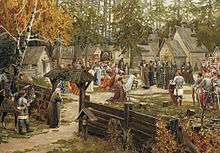
The most powerful state to eventually arise after the destruction of Kievan Rus' was the Grand Duchy of Moscow ("Muscovy" in the Western chronicles), initially a part of Vladimir-Suzdal. While still under the domain of the Mongol-Tatars and with their connivance, Moscow began to assert its influence in the Central Rus' in the early 14th century, gradually becoming the leading force in the process of the Rus' lands' reunification and expansion of Russia.[64] Moscow's last rival, the Novgorod Republic, prospered as the chief fur trade center and the easternmost port of the Hanseatic League.
Times remained difficult, with frequent Mongol-Tatar raids. Agriculture suffered from the beginning of the Little Ice Age. As in the rest of Europe, plague was a frequent occurrence between 1350 and 1490.[65] However, because of the lower population density and better hygiene—widespread practicing of banya, a wet steam bath—the death rate from plague was not as severe as in Western Europe,[66] and population numbers recovered by 1500.[65]
Led by Prince Dmitry Donskoy of Moscow and helped by the Russian Orthodox Church, the united army of Russian principalities inflicted a milestone defeat on the Mongol-Tatars in the Battle of Kulikovo in 1380. Moscow gradually absorbed the surrounding principalities, including formerly strong rivals such as Tver and Novgorod.
Ivan III ("the Great") finally threw off the control of the Golden Horde and consolidated the whole of Central and Northern Rus' under Moscow's dominion. He was also the first to take the title "Grand Duke of all the Russias".[67] After the fall of Constantinople in 1453, Moscow claimed succession to the legacy of the Eastern Roman Empire. Ivan III married Sophia Palaiologina, the niece of the last Byzantine emperor Constantine XI, and made the Byzantine double-headed eagle his own, and eventually Russia's, coat-of-arms.
Tsardom of Russia
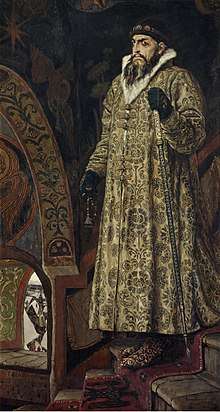
In development of the Third Rome ideas, the Grand Duke Ivan IV (the "Terrible")[68] was officially crowned first Tsar ("Caesar") of Russia in 1547. The Tsar promulgated a new code of laws (Sudebnik of 1550), established the first Russian feudal representative body (Zemsky Sobor) and introduced local self-management into the rural regions.[69][70]
During his long reign, Ivan the Terrible nearly doubled the already large Russian territory by annexing the three Tatar khanates (parts of the disintegrated Golden Horde): Kazan and Astrakhan along the Volga River, and the Siberian Khanate in southwestern Siberia. Thus, by the end of the 16th century Russia was transformed into a multiethnic, multidenominational and transcontinental state.
However, the Tsardom was weakened by the long and unsuccessful Livonian War against the coalition of Poland, Lithuania, and Sweden for access to the Baltic coast and sea trade.[71] At the same time, the Tatars of the Crimean Khanate, the only remaining successor to the Golden Horde, continued to raid Southern Russia.[72] In an effort to restore the Volga khanates, Crimeans and their Ottoman allies invaded central Russia and were even able to burn down parts of Moscow in 1571.[73] But in the next year the large invading army was thoroughly defeated by Russians in the Battle of Molodi, forever eliminating the threat of an Ottoman–Crimean expansion into Russia. The slave raids of Crimeans, however, did not cease until the late 17th century though the construction of new fortification lines across Southern Russia, such as the Great Abatis Line, constantly narrowed the area accessible to incursions.[74]
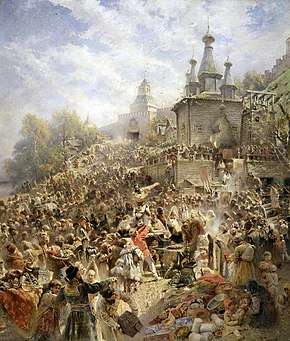
The death of Ivan's sons marked the end of the ancient Rurik Dynasty in 1598, and in combination with the famine of 1601–03[75] led to civil war, the rule of pretenders, and foreign intervention during the Time of Troubles in the early 17th century.[76] The Polish–Lithuanian Commonwealth occupied parts of Russia, including Moscow. In 1612, the Poles were forced to retreat by the Russian volunteer corps, led by two national heroes, merchant Kuzma Minin and Prince Dmitry Pozharsky. The Romanov Dynasty acceded to the throne in 1613 by the decision of Zemsky Sobor, and the country started its gradual recovery from the crisis.
Russia continued its territorial growth through the 17th century, which was the age of Cossacks. Cossacks were warriors organised into military communities, resembling pirates and pioneers of the New World. In 1648, the peasants of Ukraine joined the Zaporozhian Cossacks in rebellion against Poland-Lithuania during the Khmelnytsky Uprising in reaction to the social and religious oppression they had been suffering under Polish rule. In 1654, the Ukrainian leader, Bohdan Khmelnytsky, offered to place Ukraine under the protection of the Russian Tsar, Aleksey I. Aleksey's acceptance of this offer led to another Russo-Polish War. Finally, Ukraine was split along the Dnieper River, leaving the western part, right-bank Ukraine, under Polish rule and the eastern part (Left-bank Ukraine and Kiev) under Russian rule. Later, in 1670–71, the Don Cossacks led by Stenka Razin initiated a major uprising in the Volga Region, but the Tsar's troops were successful in defeating the rebels.
In the east, the rapid Russian exploration and colonisation of the huge territories of Siberia was led mostly by Cossacks hunting for valuable furs and ivory. Russian explorers pushed eastward primarily along the Siberian River Routes, and by the mid-17th century there were Russian settlements in Eastern Siberia, on the Chukchi Peninsula, along the Amur River, and on the Pacific coast. In 1648, the Bering Strait between Asia and North America was passed for the first time by Fedot Popov and Semyon Dezhnyov.
Imperial Russia
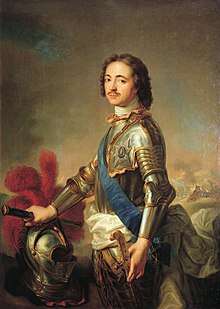
Under Peter the Great, Russia was proclaimed an Empire in 1721 and became recognised as a world power. Ruling from 1682 to 1725, Peter defeated Sweden in the Great Northern War, forcing it to cede West Karelia and Ingria (two regions lost by Russia in the Time of Troubles),[77] as well as Estland and Livland, securing Russia's access to the sea and sea trade.[78] On the Baltic Sea, Peter founded a new capital called Saint Petersburg, later known as Russia's "window to Europe". Peter the Great's reforms brought considerable Western European cultural influences to Russia.
The reign of Peter I's daughter Elizabeth in 1741–62 saw Russia's participation in the Seven Years' War (1756–63). During this conflict Russia annexed East Prussia for a while and even took Berlin. However, upon Elizabeth's death, all these conquests were returned to the Kingdom of Prussia by pro-Prussian Peter III of Russia.
Catherine II ("the Great"), who ruled in 1762–96, presided over the Age of Russian Enlightenment. She extended Russian political control over the Polish-Lithuanian Commonwealth and incorporated most of its territories into Russia during the Partitions of Poland, pushing the Russian frontier westward into Central Europe. In the south, after successful Russo-Turkish Wars against Ottoman Turkey, Catherine advanced Russia's boundary to the Black Sea, defeating the Crimean Khanate. As a result of victories over Qajar Iran through the Russo-Persian Wars, by the first half of the 19th century Russia also made significant territorial gains in Transcaucasia and the North Caucasus, forcing the former to irrevocably cede what is nowadays Georgia, Dagestan, Azerbaijan and Armenia to Russia.[79][80] Catherine's successor, her son Paul, was unstable and focused predominantly on domestic issues. Following his short reign, Catherine's strategy was continued with Alexander I's (1801–25) wresting of Finland from the weakened kingdom of Sweden in 1809 and of Bessarabia from the Ottomans in 1812. At the same time, Russians colonised Alaska and even founded settlements in California, such as Fort Ross.
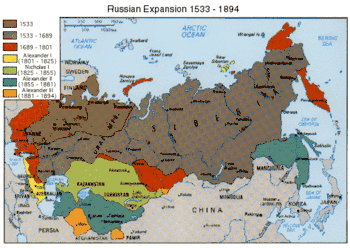
In 1803–1806, the first Russian circumnavigation was made, later followed by other notable Russian sea exploration voyages. In 1820, a Russian expedition discovered the continent of Antarctica.
In alliances with various European countries, Russia fought against Napoleon's France. The French invasion of Russia at the height of Napoleon's power in 1812 reached Moscow, but eventually failed miserably as the obstinate resistance in combination with the bitterly cold Russian winter led to a disastrous defeat of invaders, in which more than 95% of the pan-European Grande Armée perished.[81] Led by Mikhail Kutuzov and Barclay de Tolly, the Russian army ousted Napoleon from the country and drove through Europe in the war of the Sixth Coalition, finally entering Paris. Alexander I headed Russia's delegation at the Congress of Vienna that defined the map of post-Napoleonic Europe.
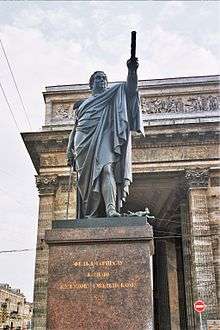
The officers of the Napoleonic Wars brought ideas of liberalism back to Russia with them and attempted to curtail the tsar's powers during the abortive Decembrist revolt of 1825. At the end of the conservative reign of Nicolas I (1825–55), a zenith period of Russia's power and influence in Europe was disrupted by defeat in the Crimean War. Between 1847 and 1851, about one million people died of Asiatic cholera.[82]
Nicholas's successor Alexander II (1855–81) enacted significant changes in the country, including the emancipation reform of 1861. These Great Reforms spurred industrialization and modernised the Russian army, which had successfully liberated Bulgaria from Ottoman rule in the 1877–78 Russo-Turkish War.
The late 19th century saw the rise of various socialist movements in Russia. Alexander II was killed in 1881 by revolutionary terrorists, and the reign of his son Alexander III (1881–94) was less liberal but more peaceful. The last Russian Emperor, Nicholas II (1894–1917), was unable to prevent the events of the Russian Revolution of 1905, triggered by the unsuccessful Russo-Japanese War and the demonstration incident known as Bloody Sunday. The uprising was put down, but the government was forced to concede major reforms (Russian Constitution of 1906), including granting the freedoms of speech and assembly, the legalization of political parties, and the creation of an elected legislative body, the State Duma of the Russian Empire. The Stolypin agrarian reform led to a massive peasant migration and settlement into Siberia. More than four million settlers arrived in that region between 1906 and 1914.[83]
February Revolution and Russian Republic
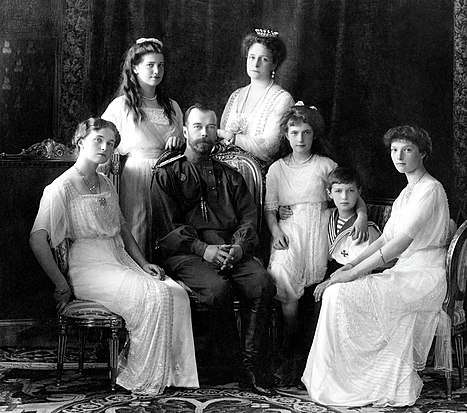
In 1914, Russia entered World War I in response to Austria-Hungary's declaration of war on Russia's ally Serbia, and fought across multiple fronts while isolated from its Triple Entente allies. In 1916, the Brusilov Offensive of the Russian Army almost completely destroyed the military of Austria-Hungary. However, the already-existing public distrust of the regime was deepened by the rising costs of war, high casualties, and rumors of corruption and treason. All this formed the climate for the Russian Revolution of 1917, carried out in two major acts.
The February Revolution forced Nicholas II to abdicate; he and his family were imprisoned and later executed in Yekaterinburg during the Russian Civil War. The monarchy was replaced by a shaky coalition of political parties that declared itself the Provisional Government. On 1 September (14), 1917, upon a decree of the Provisional Government, the Russian Republic was proclaimed.[84] On 6 January (19), 1918, the Russian Constituent Assembly declared Russia a democratic federal republic (thus ratifying the Provisional Government's decision). The next day the Constituent Assembly was dissolved by the All-Russian Central Executive Committee.
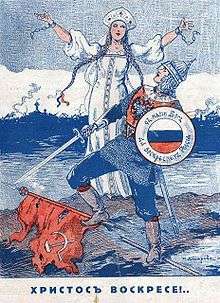
Soviet Russia and civil war
An alternative socialist establishment co-existed, the Petrograd Soviet, wielding power through the democratically elected councils of workers and peasants, called Soviets. The rule of the new authorities only aggravated the crisis in the country, instead of resolving it. Eventually, the October Revolution, led by Bolshevik leader Vladimir Lenin, overthrew the Provisional Government and gave full governing power to the Soviets, leading to the creation of the world's first socialist state.
Following the October Revolution, a civil war broke out between the anti-Communist White movement and the new Soviet regime with its Red Army. Bolshevist Russia lost its Ukrainian, Polish, Baltic, and Finnish territories by signing the Treaty of Brest-Litovsk that concluded hostilities with the Central Powers of World War I. The Allied powers launched an unsuccessful military intervention in support of anti-Communist forces. In the meantime both the Bolsheviks and White movement carried out campaigns of deportations and executions against each other, known respectively as the Red Terror and White Terror. By the end of the civil war, Russia's economy and infrastructure were heavily damaged. There were an estimated 7–12 million casualties during the war, mostly civilians.[85] Millions became White émigrés,[86] and the Russian famine of 1921–22 claimed up to five million victims.[87]
Soviet Union
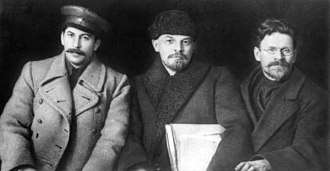
.svg.png)
.svg.png)
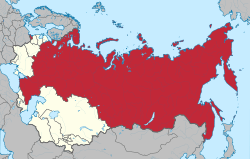
The Russian Soviet Federative Socialist Republic (called Russian Socialist Federative Soviet Republic at the time), together with the Ukrainian, Byelorussian, and Transcaucasian Soviet Socialist Republics, formed the Union of Soviet Socialist Republics (USSR), or Soviet Union, on 30 December 1922. Out of the 15 republics that would make up the USSR, the largest in size and over half of the total USSR population was the Russian SFSR, which came to dominate the union for its entire 69-year history.
Following Lenin's death in 1924, a troika was designated to govern the Soviet Union. However, Joseph Stalin, an elected General Secretary of the Communist Party, managed to suppress all opposition groups within the party and consolidate power in his hands. Leon Trotsky, the main proponent of world revolution, was exiled from the Soviet Union in 1929, and Stalin's idea of Socialism in One Country became the primary line. The continued internal struggle in the Bolshevik party culminated in the Great Purge, a period of mass repressions in 1937–38, during which hundreds of thousands of people were executed, including original party members and military leaders accused of coup d'état plots.[88]
Under Stalin's leadership, the government launched a command economy, industrialization of the largely rural country, and collectivization of its agriculture. During this period of rapid economic and social change, millions of people were sent to penal labor camps,[89] including many political convicts for their opposition to Stalin's rule; millions were deported and exiled to remote areas of the Soviet Union.[89] The transitional disorganisation of the country's agriculture, combined with the harsh state policies and a drought, led to the Soviet famine of 1932–1933,[90] which killed between 2 and 3 million people in the Russian SFSR.[91] The Soviet Union made the costly transformation from a largely agrarian economy to a major industrial powerhouse in a short span of time.
Under the doctrine of state atheism in the Soviet Union, there was a "government-sponsored program of forced conversion to atheism" conducted by Communists.[92][93][94] The communist regime targeted religions based on State interests, and while most organised religions were never outlawed, religious property was confiscated, believers were harassed, and religion was ridiculed while atheism was propagated in schools.[95] In 1925 the government founded the League of Militant Atheists to intensify the persecution.[96] Accordingly, although personal expressions of religious faith were not explicitly banned, a strong sense of social stigma was imposed on them by the official structures and mass media and it was generally considered unacceptable for members of certain professions (teachers, state bureaucrats, soldiers) to be openly religious. As for the Russian Orthodox Church, Soviet authorities sought to control it and, in times of national crisis, to exploit it for the regime's own purposes; but their ultimate goal was to eliminate it. During the first five years of Soviet power, the Bolsheviks executed 28 Russian Orthodox bishops and over 1,200 Russian Orthodox priests.[97] Many others were imprisoned or exiled. Believers were harassed and persecuted. Most seminaries were closed, and the publication of most religious material was prohibited. By 1941 only 500 churches remained open out of about 54,000 in existence prior to World War I.
World War II
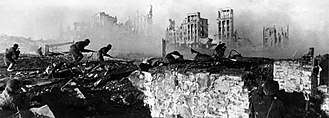
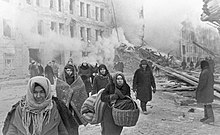
The Appeasement policy of Great Britain and France towards Adolf Hitler's annexation of Austria and Czechoslovakia did not stem an increase in the power of Nazi Germany. Around the same time, the Third Reich allied with the Empire of Japan, a rival of the USSR in the Far East and an open enemy of the USSR in the Soviet–Japanese Border Wars in 1938–39.
In August 1939, the Soviet government decided to improve relations with Germany by concluding the Molotov–Ribbentrop Pact, pledging non-aggression between the two countries and dividing Eastern Europe into their respective spheres of influence. When Germany launched the Invasion of Poland, the Soviets followed weeks later with their own invasion of the country, claiming the eastern half of Poland while avoiding war with the Allied Powers. The Soviet government engaged in significant cooperation with Nazi Germany between 1939 and 1941, through extensive trade agreements which supplied Germany with vital raw materials for her war effort against Britain and France. As the other European powers were busy fighting in World War II, the USSR expanded her own military, and occupied the Hertza region as a result of the Winter War, annexed the Baltic states and annexed Bessarabia and Northern Bukovina from Romania.
On 22 June 1941, Nazi Germany broke their non-aggression treaty with their erstwhile partner and invaded the Soviet Union with the largest and most powerful invasion force in human history,[98] opening the largest theater of World War II. The Nazi Hunger Plan foresaw the "extinction of industry as well as a great part of the population".[99] Nearly 3 million Soviet POWs in German captivity were murdered in just eight months of 1941–42.[100] Although the German army had considerable early success, their attack was halted in the Battle of Moscow. Subsequently, the Germans were dealt major defeats first at the Battle of Stalingrad in the winter of 1942–43,[101] and then in the Battle of Kursk in the summer of 1943. Another German failure was the Siege of Leningrad, in which the city was fully blockaded on land between 1941 and 1944 by German and Finnish forces, and suffered starvation and more than a million deaths, but never surrendered.[102] Under Stalin's administration and the leadership of such commanders as Georgy Zhukov and Konstantin Rokossovsky, Soviet forces took Eastern Europe in 1944–45 and captured Berlin in May 1945. In August 1945 the Soviet Army ousted the Japanese from China's Manchukuo and North Korea, contributing to the allied victory over Japan.

The 1941–45 period of World War II is known in Russia as the "Great Patriotic War". The Soviet Union together with the United States, the United Kingdom and China were considered as the Big Four of Allied powers in World War II[104] and later became the Four Policemen which was the foundation of the United Nations Security Council.[105] During this war, which included many of the most lethal battle operations in human history, Soviet civilian and military death were about 27 million,[106][107] accounting for about a third of all World War II casualties. The full demographic loss to the Soviet peoples was even greater.[108] The Soviet economy and infrastructure suffered massive devastation which caused the Soviet famine of 1946–47,[109] but the Soviet Union emerged as an acknowledged military superpower on the continent.
The Soviet rear was also badly damaged by the German invasion. Luftwaffe bombed the cities of the Soviet Union from the air. Gorky suffered the most from the bombing. This city was the main industrial center of the USSR and was located near the Moscow Defence Zone. The bombing of the Volga capital destroyed the largest automobile plant GAZ. This plant supplied tanks for the front. Whole residential areas and other large factories of the city were destroyed. From 1941 to 1943, German pilots bombed different areas of the city. This bombardment is comparable to the London Blitz. Some damage remains until this time.
Cold War
After the war, Eastern and Central Europe including East Germany and part of Austria was occupied by Red Army according to the Potsdam Conference. Dependent socialist governments were installed in the Eastern Bloc satellite states. Becoming the world's second nuclear weapons power, the USSR established the Warsaw Pact alliance and entered into a struggle for global dominance, known as the Cold War, with the United States and NATO. The Soviet Union supported revolutionary movements across the world, including the newly formed People's Republic of China, the Democratic People's Republic of Korea and, later on, the Republic of Cuba. Significant amounts of Soviet resources were allocated in aid to the other socialist states.[110]
After Stalin's death and a short period of collective rule, the new leader Nikita Khrushchev denounced the cult of personality of Stalin and launched the policy of de-Stalinization. The penal labor system was reformed and many prisoners were released and rehabilitated (many of them posthumously).[111] The general easement of repressive policies became known later as the Khrushchev Thaw. At the same time, tensions with the United States heightened when the two rivals clashed over the deployment of the United States Jupiter missiles in Turkey and Soviet missiles in Cuba.
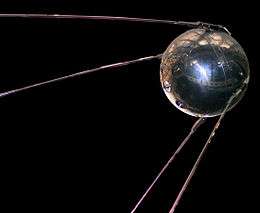
In 1957, the Soviet Union launched the world's first artificial satellite, Sputnik 1, thus starting the Space Age. Russia's cosmonaut Yuri Gagarin became the first human to orbit the Earth, aboard the Vostok 1 manned spacecraft on 12 April 1961.
Following the ousting of Khrushchev in 1964, another period of collective rule ensued, until Leonid Brezhnev became the leader. The era of the 1970s and the early 1980s was later designated as the Era of Stagnation, a period when economic growth slowed and social policies became static. The 1965 Kosygin reform aimed for partial decentralization of the Soviet economy and shifted the emphasis from heavy industry and weapons to light industry and consumer goods but was stifled by the conservative Communist leadership.
In 1979, after a Communist-led revolution in Afghanistan, Soviet forces entered that country. The occupation drained economic resources and dragged on without achieving meaningful political results. Ultimately, the Soviet Army was withdrawn from Afghanistan in 1989 due to international opposition, persistent anti-Soviet guerrilla warfare, and a lack of support by Soviet citizens.
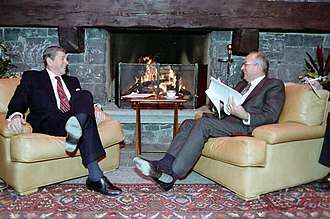
From 1985 onwards, the last Soviet leader Mikhail Gorbachev, who sought to enact liberal reforms in the Soviet system, introduced the policies of glasnost (openness) and perestroika (restructuring) in an attempt to end the period of economic stagnation and to democratise the government. This, however, led to the rise of strong nationalist and separatist movements. Prior to 1991, the Soviet economy was the second largest in the world,[112] but during its last years it was afflicted by shortages of goods in grocery stores, huge budget deficits, and explosive growth in the money supply leading to inflation.[113]
By 1991, economic and political turmoil began to boil over, as the Baltic states chose to secede from the Soviet Union. On 17 March, a referendum was held, in which the vast majority of participating citizens voted in favour of changing the Soviet Union into a renewed federation. In August 1991, a coup d'état attempt by members of Gorbachev's government, directed against Gorbachev and aimed at preserving the Soviet Union, instead led to the end of the Communist Party of the Soviet Union. On 25 December 1991, the USSR was dissolved into 15 post-Soviet states.
Post-Soviet Russia (1991–present)
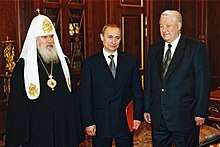
In June 1991, Boris Yeltsin became the first directly elected president in Russian history when he was elected President of the Russian Soviet Federative Socialist Republic, which became the independent Russian Federation in December of that year. The economic and political collapse of USSR led to a deep and prolonged depression, characterised by a 50% decline in both GDP and industrial output between 1990 and 1995, although some of the recorded declines may have been a result of an upward bias in Soviet-era economic data.[114][115] During and after the disintegration of the Soviet Union, wide-ranging reforms including privatization and market and trade liberalization were undertaken,[114] including radical changes along the lines of "shock therapy" as recommended by the United States and the International Monetary Fund.[116]
The privatization largely shifted control of enterprises from state agencies to individuals with inside connections in the government. Many of the newly rich moved billions in cash and assets outside of the country in an enormous capital flight.[117] The depression of the economy led to the collapse of social services; the birth rate plummeted while the death rate skyrocketed.[118] Millions plunged into poverty, from a level of 1.5% in the late Soviet era to 39–49% by mid-1993.[119] The 1990s saw extreme corruption and lawlessness, the rise of criminal gangs and violent crime.[120]
The 1990s were plagued by armed conflicts in the North Caucasus, both local ethnic skirmishes and separatist Islamist insurrections. From the time Chechen separatists declared independence in the early 1990s, an intermittent guerrilla war has been fought between the rebel groups and the Russian military. Terrorist attacks against civilians carried out by separatists, most notably the Moscow theater hostage crisis and Beslan school siege, caused hundreds of deaths and drew worldwide attention.
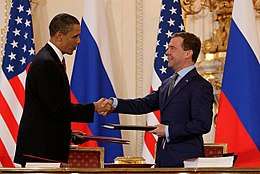
Russia took up the responsibility for settling the USSR's external debts, even though its population made up just half of the population of the USSR at the time of its dissolution.[120] In 1992, most consumer price controls were eliminated, causing extreme inflation and significantly devaluing the Ruble.[121] With a devalued Ruble, the Russian government struggled to pay back its debts to internal debtors, as well as international institutions like the International Monetary Fund.[122] Despite significant attempts at economic restructuring, Russia's debt outpaced GDP growth. High budget deficits coupled with increasing capital flight and inability to pay back debts[123] caused the 1998 Russian financial crisis[121] and resulted in a further GDP decline.[113]
On 31 December 1999, President Yeltsin unexpectedly resigned, handing the post to the recently appointed Prime Minister, Vladimir Putin, who then won the 2000 presidential election. Putin suppressed the Chechen insurgency although sporadic violence still occurs throughout the Northern Caucasus. High oil prices and the initially weak currency followed by increasing domestic demand, consumption, and investments helped the economy grow at an average of 7% per year from 1998 to 2008,[124] improving the standard of living and increasing Russia's influence on the world stage.[125] Following the world economic crisis of 2008 and a subsequent drop in oil prices, Russia's economy stagnated and poverty again started to rise[126] until 2017 when, after the prolonged recession, Russia's economy began to grow again, supported by stronger global growth, higher oil prices, and solid macro fundamentals.[126] While many reforms made during the Putin presidency have been generally criticised by Western nations as undemocratic,[127] Putin's leadership over the return of order, stability, and progress has won him widespread admiration in Russia.[128]
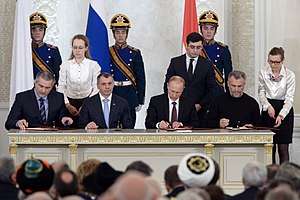
On 2 March 2008, Dmitry Medvedev was elected President of Russia while Putin became Prime Minister. Putin returned to the presidency following the 2012 presidential elections, and Medvedev was appointed Prime Minister. This quick succession in leadership change was coined "tandemocracy" by outside media. Some critics claimed that the leadership change was superficial, and that Putin remained as the decision making force in the Russian government. Within the context of the ongoing Russia–Ukraine gas dispute in early January 2009, Nikolai Petrov, an analyst with the Carnegie Moscow Center said: "What we see right now is the dominant role of Putin. We see him as a real head of state. ... This is not surprising. We are still living in Putin's Russia."[129] Some Russian political analysts and commentators viewed the political power as truly tandem between Medvedev and Putin. Prior to the 2008 election, political scientists Gleb Pavlovsky and Stanislav Belkovsky discussed the future configuration of power. According to Mr. Pavlovsky, people would be very suited with the option of the union of Putin and Medvedev "similar to the two Consuls of Rome". Belkovsky called Medvedev "President of a dream", referring to the early 1990s when people ostensibly dreamed of the time they "would live without the stranglehold of ubiquitous ideology, and a common person would become the head of the state".[130]
In 2014, after President Viktor Yanukovych of Ukraine fled as a result of a revolution, Putin requested and received authorization from the Russian Parliament to deploy Russian troops to Ukraine, leading to the takeover of Crimea.[131][132][133][134][135] Following a Crimean referendum in which separation was favored by a large majority of voters,[136][137][138][139][140][141] the Russian leadership announced the accession of Crimea into the Russian Federation, though this and the referendum that preceded it were not accepted internationally. On 27 March the United Nations General Assembly voted in favor of a non-binding resolution opposing the Russian annexation of Crimea by a vote of 100 member states in favor, 11 against and 58 abstentions.[142] The annexation of Crimea lead to sanctions by Western countries, in which the Russian government responded with its own against a number of countries.[143][144][145]
In September 2015, Russia started military intervention in the Syrian Civil War, consisting of air strikes against militant groups of the Islamic State, al-Nusra Front (al-Qaeda in the Levant), and the Army of Conquest.
Politics
Governance
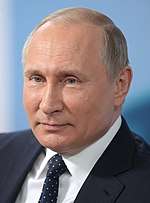 |
.jpg) |
| Vladimir Putin |
Mikhail Mishustin |
According to the Constitution of Russia, the country is an asymmetric federation and semi-presidential republic, wherein the President is the head of state[146] and the Prime Minister is the head of government. The Russian Federation is fundamentally structured as a multi-party representative democracy, with the federal government composed of three branches:
- Legislative: The bicameral Federal Assembly of Russia, made up of the 450-member State Duma and the 170-member Federation Council, adopts federal law, declares war, approves treaties, has the power of the purse and the power of impeachment of the President.
- Executive: The President is the Commander-in-Chief of the Armed Forces, can veto legislative bills before they become law, and appoints the Government of Russia (Cabinet) and other officers, who administer and enforce federal laws and policies.
- Judiciary: The Constitutional Court, Supreme Court and lower federal courts, whose judges are appointed by the Federation Council on the recommendation of the President, interpret laws and can overturn laws they deem unconstitutional.
The president is elected by popular vote for a six-year term (eligible for a second term, but not for a third consecutive term).[147] Ministries of the government are composed of the Premier and his deputies, ministers, and selected other individuals; all are appointed by the President on the recommendation of the Prime Minister (whereas the appointment of the latter requires the consent of the State Duma). Leading political parties in Russia include United Russia, the Communist Party, the Liberal Democratic Party, and A Just Russia. In 2019, Russia was ranked as 134th of 167 countries in the Democracy Index, compiled by The Economist Intelligence Unit,[148] while the World Justice Project, as of 2014, ranked Russia 80th of 99 countries surveyed in terms of rule of law.[149]
Foreign relations
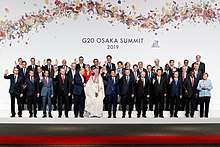
The Russian Federation is recognised in international law as a successor state of the former Soviet Union.[150] Russia continues to implement the international commitments of the USSR, and has assumed the USSR's permanent seat in the UN Security Council, membership in other international organisations, the rights and obligations under international treaties, and property and debts. Russia has a multifaceted foreign policy. As of 2009, it maintains diplomatic relations with 191 countries and has 144 embassies. The foreign policy is determined by the President and implemented by the Ministry of Foreign Affairs of Russia.[151]
Although it is the successor state to a former superpower, Russia is commonly accepted to be a major great power, as well as a regional power.[152][153] Russia is one of five permanent members of the UN Security Council. The country participates in the Quartet on the Middle East and the Six-party talks with North Korea. Russia is a member of the Council of Europe, OSCE, and APEC. Russia usually takes a leading role in regional organisations such as the CIS, EurAsEC, CSTO, and the SCO.[154] Russia became the 39th member state of the Council of Europe in 1996.[155] In 1998, Russia ratified the European Convention on Human Rights. The legal basis for EU relations with Russia is the Partnership and Cooperation Agreement, which came into force in 1997. The Agreement recalls the parties' shared respect for democracy and human rights, political and economic freedom and commitment to international peace and security.[156] In May 2003, the EU and Russia agreed to reinforce their cooperation on the basis of common values and shared interests.[157] President Vladimir Putin had advocated a strategic partnership with close integration in various dimensions, including establishment of EU-Russia Common Spaces.[158] From the dissolution of the Soviet Union, Russia has initially developed a friendlier relationship with the United States and NATO, however today, the trilateral relationship has significantly deteriorated due to several issues and conflicts between Russia and the Western countries.[159][160] The NATO-Russia Council was established in 2002 to allow the United States, Russia and the 27 allies in NATO to work together as equal partners to pursue opportunities for joint collaboration.[161]

Russia maintains strong and positive relations with other SCO and BRICS countries. In recent years, the country has significantly strengthened bilateral ties with the People's Republic of China by signing the Treaty of Friendship as well as building the Trans-Siberian oil pipeline and gas pipeline from Siberia to China, and has since formed a special relationship with China.[162][163] India is the largest customer of Russian military equipment and the two countries share extensive defense and strategic relations.[164]
An important aspect of Russia's relations with the West is the criticism of Russia's political system and human rights management (including LGBT rights, media freedom, and reports about killed journalists) by Western governments, the mass media and the leading democracy and human rights watchdogs. In particular, such organisations as Amnesty International and Human Rights Watch consider Russia to have not enough democratic attributes and to allow few political rights and civil liberties to its citizens.[165][166] Freedom House, an international organisation funded by the United States, ranks Russia as "not free", citing "carefully engineered elections" and "absence" of debate.[167] Russian authorities dismiss these claims and especially criticise Freedom House. The Russian Ministry of Foreign Affairs has called the 2006 Freedom in the World report "prefabricated", stating that the human rights issues have been turned into a political weapon in particular by the United States. The ministry also claims that such organisations as Freedom House and Human Rights Watch use the same scheme of voluntary extrapolation of "isolated facts that of course can be found in any country" into "dominant tendencies".[168]
Russia's power on the international stage depends on its petroleum revenue. If the world completes a transition to renewable energy and international demand for Russian oil, gas and coal resources is dramatically reduced, so will Russia's international power be. Russia is ranked 148 out of 156 countries in the index of Geopolitical Gains and Losses after energy transition (GeGaLo).[169]
Military
_-_04.jpg)
.jpg)
The Russian military is divided into the Ground Forces, Navy, and Air Force. There are also three independent arms of service: Strategic Missile Troops, Aerospace Defence Forces, and the Airborne Troops. As of 2017, the military comprised over one million active duty personnel, the fifth-largest in the world.[170] Additionally, there are over 2.5 million reservists, with the total number of reserve troops possibly being as high as 20 million.[171] It is mandatory for all male citizens aged 18–27 to be drafted for a year of service in Armed Forces.[125]
Russia has the largest stockpile of nuclear weapons in the world, the second-largest fleet of ballistic missile submarines, and the only modern strategic bomber force outside the United States.[172][173] More than 90% of world's 14,000 nuclear weapons are owned by Russia and the United States.[174] Russia's tank force is the largest in the world, while its surface navy and air force are among the largest.
The country has a large and fully indigenous arms industry, producing most of its own military equipment with only a few types of weapons imported. It has been one of the world's top supplier of arms since 2001, accounting for around 30% of worldwide weapons sales[175] and exporting weapons to about 80 countries.[176] The Stockholm International Peace Research Institute, SIPRI, found that Russia was the second biggest exporter of arms in 2010–14, increasing their exports by 37 per cent from the period 2005–2009. SIPRI estimated in 2020 that Russia is the third biggest exporters of arms, only behind the US and China.[177] In 2010–14, Russia delivered weapons to 56 states and to rebel forces in eastern Ukraine.[178]
The Russian government's official 2014 military budget is about 2.49 trillion rubles (approximately US$69.3 billion), the third-largest in the world behind the United States and the People's Republic of China. The official budget is set to rise to 3.03 trillion rubles (approximately US$83.7 billion) in 2015, and 3.36 trillion rubles (approximately US$93.9 billion) in 2016.[179] However, unofficial estimates put the budget significantly higher, for example the Stockholm International Peace Research Institute (SIPRI) 2013 Military Expenditure Database estimated Russia's military expenditure in 2012 at US$90.749 billion.[180] This estimate is an increase of more than US$18 billion on SIPRI's estimate of the Russian military budget for 2011 (US$71.9 billion).[181] As of 2020, Russia's military budget is higher than any other European nation.
Political divisions
.svg.png)
2.jpg)
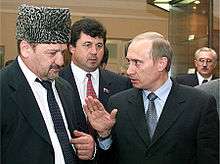
- Federal subjects
According to the Constitution, the country comprises eighty-five federal subjects,[182] including the disputed Republic of Crimea and federal city of Sevastopol.[183] In 1993, when the Constitution was adopted, there were eighty-nine federal subjects listed, but later some of them were merged. These subjects have equal representation—two delegates each—in the Federation Council.[184] However, they differ in the degree of autonomy they enjoy.
- 46 oblasts (provinces): most common type of federal subjects, with locally elected governor and legislature.[185]
- 22 republics: nominally autonomous; each is tasked with drafting its own constitution, direct-elected[185] head of republic[186] or a similar post, and parliament. Republics are allowed to establish their own official language alongside Russian but are represented by the federal government in international affairs. Republics are meant to be home to specific ethnic minorities.
- 9 krais (territories): essentially the same as oblasts. The "territory" designation is historic, originally given to frontier regions and later also to the administrative divisions that comprised autonomous okrugs or autonomous oblasts.
- 4 autonomous okrugs (autonomous districts): originally autonomous entities within oblasts and krais created for ethnic minorities, their status was elevated to that of federal subjects in the 1990s. With the exception of Chukotka Autonomous Okrug, all autonomous okrugs are still administratively subordinated to a krai or an oblast of which they are a part.
- 1 autonomous oblast (the Jewish Autonomous Oblast): historically, autonomous oblasts were administrative units subordinated to krais. In 1990, all of them except for the Jewish AO were elevated in status to that of a republic.
- 3 federal cities (Moscow, Saint Petersburg, and Sevastopol): major cities that function as separate regions.
- Federal districts
Federal subjects are grouped into eight federal districts, each administered by an envoy appointed by the President of Russia.[187] Unlike the federal subjects, the federal districts are not a subnational level of government, but are a level of administration of the federal government. Federal districts' envoys serve as liaisons between the federal subjects and the federal government and are primarily responsible for overseeing the compliance of the federal subjects with the federal laws.
Geography
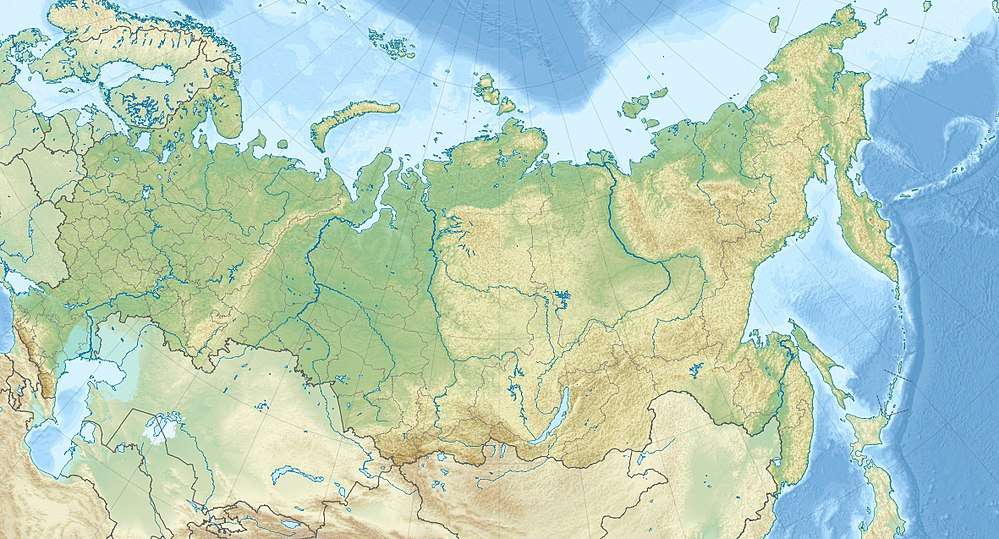

Russia is the largest country in the world; its total area is 17,075,200 square kilometres (6,592,800 sq mi).[188][189] This makes it larger than the continents of Oceania, Europe and Antarctica. It lies between latitudes 41° and 82° N, and longitudes 19° E and 169° W.
Russia's territorial expansion was achieved largely in the late 16th century under the Cossack Yermak Timofeyevich during the reign of Ivan the Terrible, at a time when competing city-states in the western regions of Russia had banded together to form one country. Yermak mustered an army and pushed eastward where he conquered nearly all the lands once belonging to the Mongols, defeating their ruler, Khan Kuchum.[190]
Russia has a wide natural resource base, including major deposits of timber, petroleum, natural gas, coal, ores and other mineral resources.
Topography
The two most widely separated points in Russia are about 8,000 km (4,971 mi) apart along a geodesic line. These points are: a 60 km (37 mi) long Vistula Spit the boundary with Poland separating the Gdańsk Bay from the Vistula Lagoon and the most southeastern point of the Kuril Islands. The points which are farthest separated in longitude are 6,600 km (4,101 mi) apart along a geodesic line. These points are: in the west, the same spit on the boundary with Poland, and in the east, the Big Diomede Island. The Russian Federation spans 11 time zones.

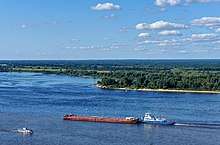
.jpg)
Most of Russia consists of vast stretches of plains that are predominantly steppe to the south and heavily forested to the north, with tundra along the northern coast. Russia possesses 10% of the world's arable land.[191] Mountain ranges are found along the southern borders, such as the Caucasus (containing Mount Elbrus, which at 5,642 m (18,510 ft) is the highest point in both Russia and Europe) and the Altai (containing Mount Belukha, which at the 4,506 m (14,783 ft) is the highest point of Siberia outside of the Russian Far East); and in the eastern parts, such as the Verkhoyansk Range or the volcanoes of Kamchatka Peninsula (containing Klyuchevskaya Sopka, which at the 4,750 m (15,584 ft) is the highest active volcano in Eurasia as well as the highest point of Asian Russia). The Ural Mountains, rich in mineral resources, form a north–south range that divides Europe and Asia.
Russia has an extensive coastline of over 37,000 km (22,991 mi) along the Arctic and Pacific Oceans, as well as along the Baltic Sea, Sea of Azov, Black Sea and Caspian Sea.[125] The Barents Sea, White Sea, Kara Sea, Laptev Sea, East Siberian Sea, Chukchi Sea, Bering Sea, Sea of Okhotsk, and the Sea of Japan are linked to Russia via the Arctic and Pacific. Russia's major islands and archipelagos include Novaya Zemlya, the Franz Josef Land, the Severnaya Zemlya, the New Siberian Islands, Wrangel Island, the Kuril Islands, and Sakhalin. The Diomede Islands (one controlled by Russia, the other by the United States) are just 3 km (1.9 mi) apart, and Kunashir Island is about 20 km (12.4 mi) from Hokkaido, Japan.
Russia has thousands of rivers and inland bodies of water, providing it with one of the world's largest surface water resources. Its lakes contain approximately one-quarter of the world's liquid fresh water.[192] The largest and most prominent of Russia's bodies of fresh water is Lake Baikal, the world's deepest, purest, oldest and most capacious fresh water lake.[193] Baikal alone contains over one-fifth of the world's fresh surface water.[192] Other major lakes include Ladoga and Onega, two of the largest lakes in Europe. Russia is second only to Brazil in volume of the total renewable water resources. Of the country's 100,000 rivers,[194] the Volga is the most famous, not only because it is the longest river in Europe, but also because of its major role in Russian history.[125] The Siberian rivers Ob, Yenisey, Lena and Amur are among the longest rivers in the world.
Climate
The enormous size of Russia and the remoteness of many areas from the sea result in the dominance of the humid continental climate, which is prevalent in all parts of the country except for the tundra and the extreme southwest. Mountains in the south obstruct the flow of warm air masses from the Indian Ocean, while the plain of the west and north makes the country open to Arctic and Atlantic influences.[195]
Most of Northern European Russia and Siberia has a subarctic climate, with extremely severe winters in the inner regions of Northeast Siberia (mostly the Sakha Republic, where the Northern Pole of Cold is located with the record low temperature of −71.2 °C or −96.2 °F), and more moderate winters elsewhere. Both the strip of land along the shore of the Arctic Ocean and the Russian Arctic islands have a polar climate.
The coastal part of Krasnodar Krai on the Black Sea, most notably in Sochi, possesses a humid subtropical climate with mild and wet winters. In many regions of East Siberia and the Far East, winter is dry compared to summer; other parts of the country experience more even precipitation across seasons. Winter precipitation in most parts of the country usually falls as snow. The region along the Lower Volga and Caspian Sea coast, as well as some areas of southernmost Siberia, possesses a semi-arid climate.
| Climate data for Russia (records) | |||||||||||||
|---|---|---|---|---|---|---|---|---|---|---|---|---|---|
| Month | Jan | Feb | Mar | Apr | May | Jun | Jul | Aug | Sep | Oct | Nov | Dec | Year |
| Record high °C (°F) | 26.7 (80.1) |
26.6 (79.9) |
30.3 (86.5) |
34.0 (93.2) |
37.7 (99.9) |
43.2 (109.8) |
45.4 (113.7) |
43.5 (110.3) |
41.5 (106.7) |
33.7 (92.7) |
29.1 (84.4) |
25.0 (77.0) |
45.4 (113.7) |
| Record low °C (°F) | −71.2 (−96.2) |
−67.8 (−90.0) |
−60.6 (−77.1) |
−57.2 (−71.0) |
−34.2 (−29.6) |
−9.7 (14.5) |
−9.3 (15.3) |
−17.1 (1.2) |
−25.3 (−13.5) |
−48.7 (−55.7) |
−58.5 (−73.3) |
−64.5 (−84.1) |
−71.2 (−96.2) |
| Source: Pogoda.ru.net[196]January record low:"February, April, May, October, December record low:[197] | |||||||||||||
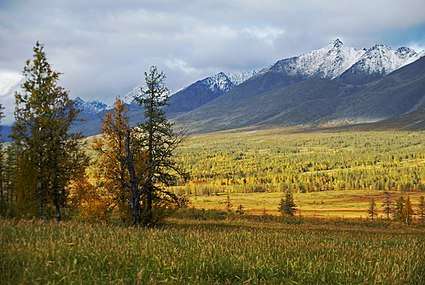
Throughout much of the territory there are only two distinct seasons—winter and summer—as spring and autumn are usually brief periods of change between extremely low and extremely high temperatures.[195] The coldest month is January (February on the coastline); the warmest is usually July. Great ranges of temperature are typical. In winter, temperatures get colder both from south to north and from west to east. Summers can be quite hot, even in Siberia.[198] The continental interiors are the driest areas.
Biodiversity

From north to south the East European Plain, also known as Russian Plain, is clad sequentially in Arctic tundra, coniferous forest (taiga), mixed and broad-leaf forests, grassland (steppe), and semi-desert (fringing the Caspian Sea), as the changes in vegetation reflect the changes in climate. Siberia supports a similar sequence but is largely taiga. Russia has the world's largest forest reserves,[199] known as "the lungs of Europe",[200] second only to the Amazon Rainforest in the amount of carbon dioxide it absorbs.
There are 266 mammal species and 780 bird species in Russia. A total of 415 animal species have been included in the Red Data Book of the Russian Federation as of 1997 and are now protected.[201] There are 28 UNESCO World Heritage Sites in Russia,[202] 40 UNESCO biosphere reserves,[203] 41 national parks and 101 nature reserves. Russia still has many ecosystems which are still untouched by man— mainly in the northern areas taiga and in subarctic tundra of Siberia. Over time Russia has been having improvement and application of environmental legislation, development and implementation of various federal and regional strategies and programmes, and study, inventory and protection of rare and endangered plants, animals, and other organisms, and including them in the Red Data Book of the Russian Federation.[204]
Economy
Russia has an upper-middle income[205] mixed economy with enormous natural resources, particularly oil and natural gas. It has the 11th largest economy in the world by nominal GDP and the 6th largest by purchasing power parity (PPP). Since the turn of the 21st century, higher domestic consumption and greater political stability have bolstered economic growth in Russia. The country ended 2008 with its ninth straight year of growth, but growth has slowed with the decline in the price of oil and gas. Real GDP per capita, PPP (current international) was 19,840 in 2010.[206] Growth was primarily driven by non-traded services and goods for the domestic market, as opposed to oil or mineral extraction and exports.[125] The average nominal salary in Russia was $967 per month in early 2013, up from $80 in 2000.[207][208] In May 2016 the average nominal monthly wages fell below $450 per month,[209] and tax on the income of individuals is payable at the rate of 13% on most incomes.[210] Approximately 19.2 million of Russians lived below the national poverty line in 2016,[211] significantly up from 16.1 million in 2015.[119] Unemployment in Russia was 5.4% in 2014, down from about 12.4% in 1999.[212] Officially, about 20–25% of the Russian population is categorised as middle class; however some economists and sociologists think this figure is inflated and the real fraction is about 7%.[213] After the United States, the European Union and other countries imposed economic sanctions after the annexation of Crimea and a collapse in oil prices, the proportion of middle-class could decrease drastically.[214][215] The economic development of the country has been uneven geographically with the Moscow region contributing a very large share of the country's GDP.[216]

Oil, natural gas, metals, and timber account for more than 80% of Russian exports abroad.[125] Since 2003, the exports of natural resources started decreasing in economic importance as the internal market strengthened considerably. As of 2012 the oil-and-gas sector accounted for 16% of GDP, 52% of federal budget revenues and over 80% of total exports.[217][218][219] Oil export earnings allowed Russia to increase its foreign reserves from $12 billion in 1999 to $597.3 billion on 1 August 2008. As of April 2017, foreign reserves in Russia fell to US$332 Billion.[220] The macroeconomic policy under Finance Minister Alexei Kudrin was prudent and sound, with excess income being stored in the Stabilization Fund of Russia.[221] In 2006, Russia repaid most of its formerly massive debts,[222] leaving it with one of the lowest foreign debts among major economies.[223] The Stabilization Fund helped Russia to come out of the global financial crisis in a much better state than many experts had expected.[221]


A simpler, more streamlined tax code adopted in 2001 reduced the tax burden on people and dramatically increased state revenue.[224] Russia has a flat tax rate of 13%. This ranks it as the country with the second most attractive personal tax system for single managers in the world after the United Arab Emirates.[225] According to Bloomberg, Russia is considered well ahead of most other resource-rich countries in its economic development, with a long tradition of education, science, and industry.[226] The country has a higher proportion of higher education graduates than any other country in Eurasia.[227]
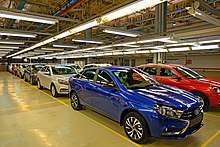
Inequality of household income and wealth has also been noted, with Credit Suisse finding Russian wealth distribution so much more extreme than other countries studied it "deserves to be placed in a separate category."[228][229] Another problem is modernisation of infrastructure, ageing and inadequate after years of being neglected in the 1990s; the government has said $1 trillion will be invested in development of infrastructure by 2020.[230] In December 2011, Russia was approved as a member of the World Trade Organisation after 18 years of dialogue, allowing it a greater access to overseas markets.[231] Some analysts estimate that WTO membership could bring the Russian economy a bounce of up to 3% annually.[232] Russia ranks as the second-most corrupt country in Europe (after Ukraine), according to the Corruption Perceptions Index. The Norwegian-Russian Chamber of Commerce also states that "[c]orruption is one of the biggest problems both Russian and international companies have to deal with."[233] Corruption in Russia is perceived as a significant problem[234] impacting all aspects of life, including public administration,[235][236] law enforcement,[237] healthcare[238] and education.[239] The phenomenon of corruption is strongly established in the historical model of public governance in Russia and attributed to general weakness of rule of law in Russia.[235] According to Transparency International's Corruption Perceptions Index, Russia's public sector ranked 137th (out of 180 countries) with a score of 28 out of 100 in 2019.[240]
The Russian central bank announced plans in 2013 to free float the Russian ruble in 2015. According to a stress test conducted by the central bank Russian financial system would be able to handle a currency decline of 25%–30% without major central bank interference. However, the Russian economy began stagnating in late 2013 and in combination with the War in Donbass is in danger of entering stagflation, slow growth and high inflation. The recent decline in the Russian ruble has increased the costs for Russian companies to make interest payments on debt issued in U.S. dollar or other foreign currencies that have strengthened against the ruble; thus it costs Russian companies more of their ruble-denominated revenue to repay their debt holders in dollars or other foreign currencies.[241] As of March 2016, the ruble was devalued more than 50 percent since July 2014.[242] Moreover, after bringing inflation down to 3.6% in 2012, the lowest rate since gaining independence from the Soviet Union, inflation in Russia jumped to nearly 7.5% in 2014, causing the central bank to increase its lending rate to 8% from 5.5% in 2013.[243][244][245] In an October 2014 article in Bloomberg Business Week, it was reported that Russia had significantly started shifting its economy towards China in response to increasing financial tensions following its annexation of Crimea and subsequent Western economic sanctions.[246]
Energy
In recent years, Russia has frequently been described in the media as an energy superpower.[247][248] The country has the world's largest natural gas reserves,[249] the 8th largest oil reserves,[250] and the second largest coal reserves.[251] Russia is the world's leading natural gas exporter[252] and second largest natural gas producer,[38] while also the largest oil exporter and the largest oil producer.[37]
Russia is the third largest electricity producer in the world[253] and the 5th largest renewable energy producer, the latter because of the well-developed hydroelectricity production in the country.[254] Large cascades of hydropower plants are built in European Russia along big rivers like the Volga. The Asian part of Russia also features a number of major hydropower stations; however, the gigantic hydroelectric potential of Siberia and the Russian Far East largely remains unexploited.
Russia was the first country to develop civilian nuclear power and to construct the world's first nuclear power plant. Currently the country is the 4th largest nuclear energy producer,[255] with all nuclear power in Russia being managed by Rosatom State Corporation. The sector is rapidly developing, with an aim of increasing the total share of nuclear energy from current 16.9% to 23% by 2020. The Russian government plans to allocate 127 billion rubles ($5.42 billion) to a federal program dedicated to the next generation of nuclear energy technology. About 1 trillion rubles ($42.7 billion) is to be allocated from the federal budget to nuclear power and industry development before 2015.[256]
In May 2014 on a two-day trip to Shanghai, President Putin signed a deal on behalf of Gazprom for the Russian energy giant to supply China with 38 billion cubic meters of natural gas per year. Construction of a pipeline to facilitate the deal was agreed whereby Russia would contribute $55bn to the cost, and China $22bn, in what Putin described as "the world's biggest construction project for the next four years." The natural gas would begin to flow sometime between 2018 and 2020 and would continue for 30 years at an ultimate cost to China of $400bn.[257]
External trade and investment
.jpg)
Russia recorded a trade surplus of US$130.1 billion in 2017.[258] Russia's Trade Balance recorded a surplus of US$19.7 billion in October 2018, compared with a surplus of US$10.1 billion in October 2017.[259]
The European Union is Russia's largest trading partner and Russia is the EU's fourth largest trading partner. 75% of foreign direct investment (FDI) stocks in Russia come from the EU.[260]
Reuters reported that U.S. companies "generated more than $90 billion in revenue from Russia in 2017."[261] According to the AALEP, "there are almost 3,000 American companies in Russia, and the U.S. is also the leader in terms of foreign companies in Special Economic Zones, with 11 projects."[262]
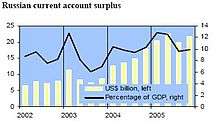
Russia recorded a trade surplus of US$15.8 billion in 2013.[263] Balance of trade in Russia is reported by the Central Bank of Russia. Historically, from 1997 until 2013, Russia balance of trade averaged US$8338.23 million reaching an all-time high of US$20647 million in December 2011 and a record low of −185 USD million in February 1998. Russia runs regular trade surpluses primarily due to exports of commodities.
In 2015, Russia main exports are oil and natural gas (62.8% of total exports), ores and metals (5.9%), chemical products (5.8%), machinery and transport equipment (5.4%) and food (4.7%). Others include: agricultural raw materials (2.2%) and textiles (0.2%).[264]
Russia imports food, ground transports, pharmaceuticals and textile and footwear. Main trading partners are: China (7% of total exports and 10% of imports), Germany (7% of exports and 8% of imports) and Italy. This page includes a chart with historical data for Russia balance of trade. Exports in Russia decreased to US$39038 million in January 2013 from US$48568 million in December 2012. Exports in Russia is reported by the Central Bank of Russia. Historically, from 1994 until 2013, Russia Exports averaged US$18668.83 million reaching an all-time high of US$51338 million in December 2011 and a record low of US$4087 million in January 1994. Russia is the 16th largest export economy in the world (2016)[265] and is a leading exporter of oil and natural gas. In Russia, services are the biggest sector of the economy and account for 58% of GDP. Within services the most important segments are: wholesale and retail trade, repair of motor vehicles, motorcycles and personal and household goods (17% of total GDP); public administration, health and education (12%); real estate (9%) and transport storage and communications (7%). Industry contributes 40% to total output. Mining (11% of GDP), manufacturing (13%) and construction (4%) are the most important industry segments. Agriculture accounts for the remaining 2%. This page includes a chart with historical data for Russia Exports. Imports in Russia decreased to US$21296 million in January 2013 from US$31436 million in December 2012. Imports in Russia is reported by the Central Bank of Russia. Historically, from 1994 until 2013, Russia imports averaged US$11392.06 million reaching an all-time high of US$31553 million in October 2012 and a record low of US$2691 million in January 1999. Russia main imports are food (13% of total imports) and ground transports (12%). Others include: pharmaceuticals, textile and footwear, plastics and optical instruments. Main import partners are China (10% of total imports) and Germany (8%). Others include: Italy, France, Japan and United States. This page includes a chart with historical data for Russia Imports.
Foreign trade of Russia – Russian export and import[266]
| Year | 2005 | 2006 | 2007 | 2008 | 2009 | 2010 | 2011 | 2012 | 2013 | 2014 | 2015 | 2016 |
|---|---|---|---|---|---|---|---|---|---|---|---|---|
| Export (US$ Billions) | 241 | 302 | 352 | 468 | 302 | 397 | 517 | 525 | 527 | 498 | 344 | 285 |
| Import (US$ Billions) | 99 | 138 | 200 | 267 | 171 | 229 | 306 | 316 | 315 | 287 | 183 | 182 |
| Top Trading Partners for Russia for 2015 [266] | |||||||||||||||||||||||||||||||||||||||||||||||||||||||||||||||||||||||||||||||||||||||||||||||||||||||||||
|---|---|---|---|---|---|---|---|---|---|---|---|---|---|---|---|---|---|---|---|---|---|---|---|---|---|---|---|---|---|---|---|---|---|---|---|---|---|---|---|---|---|---|---|---|---|---|---|---|---|---|---|---|---|---|---|---|---|---|---|---|---|---|---|---|---|---|---|---|---|---|---|---|---|---|---|---|---|---|---|---|---|---|---|---|---|---|---|---|---|---|---|---|---|---|---|---|---|---|---|---|---|---|---|---|---|---|---|
|
| ||||||||||||||||||||||||||||||||||||||||||||||||||||||||||||||||||||||||||||||||||||||||||||||||||||||||||
Foreign trade rose 34% to $151.5 billion in the first half of 2005, mainly due to the increase in oil and gas prices which now form 64% of all exports by value. Trade with CIS countries is up 13.2% to $23.3 billion. Trade with the EU forms 52.9%, with the CIS 15.4%, Eurasian Economic Community 7.8% and Asia-Pacific Economic Cooperation 15.9%.[267]
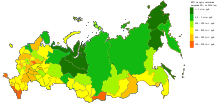
Agriculture
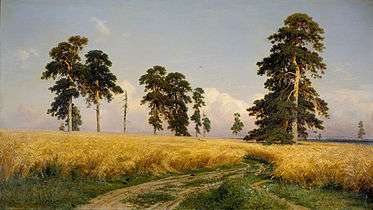
Russia's total area of cultivated land is estimated at 1,237,294 square kilometres (477,722 sq mi), the fourth largest in the world.[268] From 1999 to 2009, Russia's agriculture grew steadily,[269] and the country turned from a grain importer to the third largest grain exporter after the EU and the United States.[270] The production of meat has grown from 6,813,000 tonnes in 1999 to 9,331,000 tonnes in 2008, and continues to grow.[271]
The 2014 devaluation of the rouble and imposition of sanctions spurred domestic production, and in 2016 Russia exceeded Soviet grain production levels,[272] and became the world's largest exporter of wheat.[273]
This restoration of agriculture was supported by a credit policy of the government, helping both individual farmers and large privatised corporate farms that once were Soviet kolkhozes and which still own the significant share of agricultural land.[274] While large farms concentrate mainly on grain production and husbandry products, small private household plots produce most of the country's potatoes, vegetables and fruits.[275]
Since Russia borders three oceans (the Atlantic, Arctic, and Pacific), Russian fishing fleets are a major world fish supplier. Russia captured 3,191,068 tons of fish in 2005.[276] Both exports and imports of fish and sea products grew significantly in recent years, reaching $2,415 and $2,036 million, respectively, in 2008.[277]
Sprawling from the Baltic Sea to the Pacific Ocean, Russia has more than a fifth of the world's forests, which makes it the largest forest country in the world.[199][278] However, according to a 2012 study by the Food and Agriculture Organization of the United Nations and the Government of the Russian Federation,[279] the considerable potential of Russian forests is underutilised and Russia's share of the global trade in forest products is less than four percent.[280]
Transport
Railway transport in Russia is mostly under the control of the state-run Russian Railways monopoly. The company accounts for over 3.6% of Russia's GDP and handles 39% of the total freight traffic (including pipelines) and more than 42% of passenger traffic.[281] The total length of common-used railway tracks exceeds 85,500 km (53,127 mi),[281] second only to the United States. Over 44,000 km (27,340 mi) of tracks are electrified,[282] which is the largest number in the world, and additionally there are more than 30,000 km (18,641 mi) of industrial non-common carrier lines. Railways in Russia, unlike in the most of the world, use broad gauge of 1,520 mm (4 ft 11 27⁄32 in), with the exception of 957 km (595 mi) on Sakhalin island using narrow gauge of 1,067 mm (3 ft 6 in). The most renowned railway in Russia is Trans-Siberian (Transsib), spanning a record seven time zones and serving the longest single continuous services in the world, Moscow-Vladivostok (9,259 km (5,753 mi)), Moscow–Pyongyang (10,267 km (6,380 mi))[283] and Kiev–Vladivostok (11,085 km (6,888 mi)).[284]
As of 2006 Russia had 933,000 km of roads, of which 755,000 were paved.[285] Some of these make up the Russian federal motorway system. With a large land area the road density is the lowest of all the G8 and BRIC countries.[286]
Much of Russia's inland waterways, which total 102,000 km (63,380 mi), are made up of natural rivers or lakes. In the European part of the country the network of channels connects the basins of major rivers. Russia's capital, Moscow, is sometimes called "the port of the five seas", because of its waterway connections to the Baltic, White, Caspian, Azov and Black Seas.
Major sea ports of Russia include Rostov-on-Don on the Azov Sea, Novorossiysk on the Black Sea, Astrakhan and Makhachkala on the Caspian, Kaliningrad and St Petersburg on the Baltic, Arkhangelsk on the White Sea, Murmansk on the Barents Sea, Petropavlovsk-Kamchatsky and Vladivostok on the Pacific Ocean. In 2008 the country owned 1,448 merchant marine ships. The world's only fleet of nuclear-powered icebreakers advances the economic exploitation of the Arctic continental shelf of Russia and the development of sea trade through the Northern Sea Route between Europe and East Asia.
By total length of pipelines Russia is second only to the United States. Currently many new pipeline projects are being realised, including Nord Stream and South Stream natural gas pipelines to Europe, and the Eastern Siberia – Pacific Ocean oil pipeline (ESPO) to the Russian Far East and China.
Russia has 1,216 airports,[288] the busiest being Sheremetyevo, Domodedovo, and Vnukovo in Moscow, and Pulkovo in St. Petersburg.
Typically, major Russian cities have well-developed systems of public transport, with the most common varieties of exploited vehicles being bus, trolleybus and tram. Seven Russian cities, namely Moscow, Saint Petersburg, Nizhny Novgorod, Novosibirsk, Samara, Yekaterinburg, and Kazan, have underground metros, while Volgograd features a metrotram. The total length of metros in Russia is 465.4 kilometres (289.2 mi). Moscow Metro and Saint Petersburg Metro are the oldest in Russia, opened in 1935 and 1955 respectively. These two are among the fastest and busiest metro systems in the world, and some of them are famous for rich decorations and unique designs of their stations,[289] which is a common tradition in Russian metros and railways.[290]
Science and technology
.jpg)

Science and technology in Russia blossomed since the Age of Enlightenment, when Peter the Great founded the Russian Academy of Sciences and Saint Petersburg State University, and polymath Mikhail Lomonosov established the Moscow State University, paving the way for a strong native tradition in learning and innovation. In the 19th and 20th centuries the country produced a large number of notable scientists and inventors.
The Russian physics school began with Lomonosov who proposed the law of conservation of matter preceding the energy conservation law. Russian discoveries and inventions in physics include the electric arc, electrodynamical Lenz's law, space groups of crystals, photoelectric cell, superfluidity, Cherenkov radiation, electron paramagnetic resonance, heterotransistors and 3D holography. Lasers and masers were co-invented by Nikolai Basov and Alexander Prokhorov, while the idea of tokamak for controlled nuclear fusion was introduced by Igor Tamm, Andrei Sakharov and Lev Artsimovich, leading eventually the modern international ITER project, where Russia is a party.
Since the time of Nikolay Lobachevsky (the "Copernicus of Geometry" who pioneered the non-Euclidean geometry) and a prominent tutor Pafnuty Chebyshev, the Russian mathematical school became one of the most influential in the world.[291] Chebyshev's students included Aleksandr Lyapunov, who founded the modern stability theory, and Andrey Markov who invented the Markov chains. In the 20th century Soviet mathematicians, such as Andrey Kolmogorov, Israel Gelfand, and Sergey Sobolev, made major contributions to various areas of mathematics. Nine Soviet/Russian mathematicians were awarded with the Fields Medal, a most prestigious award in mathematics. Recently Grigori Perelman was offered the first ever Clay Millennium Prize Problems Award for his final proof of the Poincaré conjecture in 2002.[292]
Russian chemist Dmitry Mendeleev invented the Periodic table, the main framework of modern chemistry. Aleksandr Butlerov was one of the creators of the theory of chemical structure, playing a central role in organic chemistry. Russian biologists include Dmitry Ivanovsky who discovered viruses, Ivan Pavlov who was the first to experiment with the classical conditioning, and Ilya Mechnikov who was a pioneer researcher of the immune system and probiotics.
Many Russian scientists and inventors were émigrés, like Igor Sikorsky, who built the first airliners and modern-type helicopters; Vladimir Zworykin, often called the father of television; chemist Ilya Prigogine, noted for his work on dissipative structures and complex systems; Nobel Prize-winning economists Simon Kuznets and Wassily Leontief; physicist Georgiy Gamov (an author of the Big Bang theory) and social scientist Pitirim Sorokin. Many foreigners worked in Russia for a long time, like Leonard Euler and Alfred Nobel.
Russian inventions include arc welding by Nikolay Benardos, further developed by Nikolay Slavyanov, Konstantin Khrenov and other Russian engineers. Gleb Kotelnikov invented the knapsack parachute, while Evgeniy Chertovsky introduced the pressure suit. Alexander Lodygin and Pavel Yablochkov were pioneers of electric lighting, and Mikhail Dolivo-Dobrovolsky introduced the first three-phase electric power systems, widely used today. Sergei Lebedev invented the first commercially viable and mass-produced type of synthetic rubber. The first ternary computer, Setun, was developed by Nikolay Brusentsov.
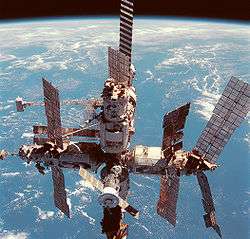
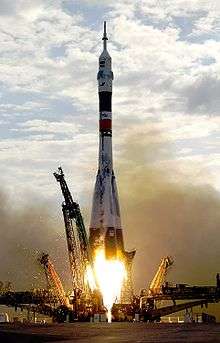
In the 20th century a number of prominent Soviet aerospace engineers, inspired by the fundamental works of Nikolai Zhukovsky, Sergei Chaplygin and others, designed many hundreds of models of military and civilian aircraft and founded a number of KBs (Construction Bureaus) that now constitute the bulk of Russian United Aircraft Corporation. Famous Russian aircraft include the civilian Tu-series, Su and MiG fighter aircraft, Ka and Mi-series helicopters; many Russian aircraft models are on the list of most produced aircraft in history.
Famous Russian battle tanks include T34, the most heavily produced tank design of World War II,[293] and further tanks of T-series, including the most produced tank in history, T54/55.[294] The AK47 and AK74 by Mikhail Kalashnikov constitute the most widely used type of assault rifle throughout the world—so much so that more AK-type rifles have been manufactured than all other assault rifles combined.[295]
With all these achievements, however, since the late Soviet era Russia was lagging behind the West in a number of technologies, mostly those related to energy conservation and consumer goods production. The crisis of the 1990s led to the drastic reduction of the state support for science and a brain drain migration from Russia.
In the 2000s, on the wave of a new economic boom, the situation in the Russian science and technology has improved, and the government launched a campaign aimed into modernisation and innovation. Russian President Dmitry Medvedev formulated top priorities for the country's technological development:
- Efficient energy use
- Information technology, including both common products and the products combined with space technology
- Nuclear energy
- Pharmaceuticals[296]
Currently Russia has completed the GLONASS satellite navigation system. The country is developing its own fifth-generation jet fighter and constructing the first serial mobile nuclear plant in the world.
Space exploration
Russian achievements in the field of space technology and space exploration are traced back to Konstantin Tsiolkovsky, the father of theoretical astronautics.[297] His works had inspired leading Soviet rocket engineers, such as Sergey Korolyov, Valentin Glushko, and many others who contributed to the success of the Soviet space program in the early stages of the Space Race and beyond.
In 1957 the first Earth-orbiting artificial satellite, Sputnik 1, was launched; in 1961 the first human trip into space was successfully made by Yuri Gagarin. Many other Soviet and Russian space exploration records ensued, including the first spacewalk performed by Alexei Leonov, Luna 9 was the first spacecraft to land on the Moon, Zond 5 brought the first Earthlings (two tortoises and other life forms) to circumnavigate the Moon, Venera 7 was the first to land on another planet (Venus), Mars 3 then the first to land on Mars, the first space exploration rover Lunokhod 1, and the first space station Salyut 1 and Mir.
After the collapse of the Soviet Union, some government-funded space exploration programs, including the Buran space shuttle program, were cancelled or delayed, while participation of the Russian space industry in commercial activities and international cooperation intensified. Nowadays Russia is the largest satellite launcher.[298] After the United States Space Shuttle program ended in 2011, Soyuz rockets became the only provider of transport for astronauts at the International Space Station.
Luna-Glob is a Russian Moon exploration programme, with first planned mission launch in 2021. Roscosmos is also developing the Orel spacecraft, to replace the aging Soyuz, it could also conduct mission to lunar orbit as early as 2026.[299][300] In February 2019, it was announced that Russia is intending to conduct its first crewed mission to land on the Moon in 2031.[301]
Water supply and sanitation
In Russia, approximately 70 per cent of drinking water comes from surface water and 30 per cent from groundwater. In 2004, water supply systems had a total capacity of 90 million cubic metres a day. The average residential water use was 248 litres per capita per day.[302] One fourth of the world's fresh surface and groundwater is located in Russia. The water utilities sector is one of the largest industries in Russia serving the entire Russian population.
Lake Baikal is famous for its record depth and clear waters. It contains 20% of the world's liquid fresh water. However, as water pollution gets worse, the lake is going to be a swamp instead of a freshwater lake soon.[303]
Corruption
_54.jpg)
There are many different estimates of the actual cost of corruption.[304] According to official government statistics from Rosstat, the "shadow economy" occupied only 15% of Russia's GDP in 2011, and this included unreported salaries (to avoid taxes and social payments) and other types of tax evasion.[305] According to Rosstat's estimates, corruption in 2011 amounted to only 3.5 to 7% of GDP. In comparison, some independent experts maintain that corruption consumes as much of 25% of Russia's GDP.[306] A World Bank report puts this figure at 48%.[307] There is also an interesting shift in the main focus of bribery: whereas previously officials took bribes to shut their eyes to legal infractions, they now take them simply to perform their duties.[308] Many experts admit that in recent years corruption in Russia has become a business. In the 1990s, businessmen had to pay different criminal groups to provide a "krysha" (literally, a "roof", i.e., protection). Nowadays, this "protective" function is performed by officials. Corrupt hierarchies characterise different sectors of the economy,[304] including education.[304]
In the end, the Russian population pays for this corruption.[304] For example, some experts believe that the rapid increases in tariffs for housing, water, gas and electricity, which significantly outpace the rate of inflation, are a direct result of high volumes of corruption at the highest levels.[309] In the recent years the reaction to corruption has changed: starting from Putin's second term, very few corruption cases have been the subject of outrage. Putin's system is remarkable for its ubiquitous and open merging of the civil service and business, as well as its use of relatives, friends, and acquaintances to benefit from budgetary expenditures and take over state property. Corporate, property, and land raiding is commonplace.[304]
On 26 March 2017, protests against alleged corruption in the federal government took place simultaneously in many cities across the country.[310] They were triggered by the lack of proper response from the Russian authorities to the published investigative film He Is Not Dimon To You, which has garnered more than 20 million views on YouTube.[311]
In the 2018 results of the Corruption Perceptions Index by Transparency International, Russia ranked 138th out of 180 countries with a score of 28 out of 100, tying with Guinea, Iran, Lebanon, Mexico and Papua New Guinea.[312]
Demographics

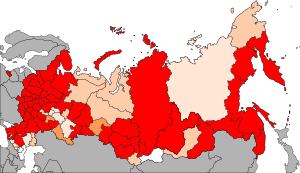

With a population of 142.8 million according to the 2010 census,[314] rising to 146.7 million as of 2020.[315] Russia is the most populous country in Europe, and the ninth-most populous country in the world, its population density stands at 9 inhabitants per square kilometre (23 per square mile). The overall life expectancy in Russia at birth is 72.4 years (66.9 years for males and 77.6 years for females).[316] Since the 1990s, Russia's death rate has exceeded its birth rate.[317] As of 2018, the total fertility rate (TFR) across Russia was estimated to be 1.57 born per woman,[318] one of the lowest fertility rates in the world,[319] below the replacement rate of 2.1, and considerably below the high of 7.44 children born per woman in 1908.[320] Subsequently, the country has one of the oldest population in the world, with an average age of 40.3 years.[319]
Nevertheless, Russia's overall birth rate is higher than that of most European countries (13.3 births per 1000 people in 2014[321] compared to the European Union average of 10.1 per 1000),[322] though its death rate is also substantially higher (in 2014, Russia's death rate was 13.1 per 1000 people[321] compared to the EU average of 9.7 per 1000).[322] Since 2010, Russia has seen increased population growth due to declining death rates, increased birth rates and increased immigration.[321] In 2009, it recorded annual population growth for the first time in fifteen years, with total growth of 10,500.[321][323][321] In 2012, the trend continued, with 1,896,263 births, the highest since 1990, and even exceeding annual births during the period 1967–1969.
Russia is home to approximately 111 million ethnic Russians,[324] and about 20 million ethnic Russians live outside Russia in the former republics of the Soviet Union, mostly in Ukraine and Kazakhstan.[325] The 2010 census recorded 81% of the population as ethnically Russian, and 19% as other ethnicities:[5] 3.7% Tatars; 1.4% Ukrainians; 1.1% Bashkirs; 1% Chuvashes; 11.8% others and unspecified. According to the Census, 84.93% of the Russian population belongs to European ethnic groups (Slavic, Germanic, Finnic, Greek, and others).[5]
The government is implementing a number of programs designed to increase the birth rate and attract more migrants. Monthly government child-assistance payments were doubled to US$55, and a one-time payment of US$9,200 has been offered to women who have a second child since 2007.[326]
The number of Russian emigrants steadily declined from 359,000 in 2000 to 32,000 in 2009.[321] According to the UN, Russia's immigrant population is the third largest in the world, numbering 11.6 million.[327] Ukraine, Uzbekistan, Tajikistan, Azerbaijan, Moldova and Kazakhstan were the leading countries of origin for immigrants to Russia.[328] There are about 3 million Ukrainians living in Russia.[329] In 2016, 196,000 migrants arrived, mostly from the ex-Soviet states.[330]
Since 2006, the Russian government started simplifying immigration laws and launched a state program "for providing assistance to voluntary immigration of ethnic Russians from former Soviet republics".[331] In light of these trends, President Putin declared that Russia's population could reach 146 million by 2025, mainly as a result of immigration.[332]
Largest cities
Ethnic groups
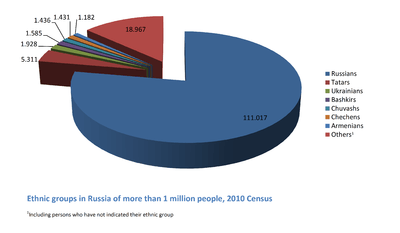
Ethnic Russians comprise 81% of the country's population.[5] Russia is a multi-national state with over 185 ethnic groups designated as nationalities; the populations of these groups vary enormously, from millions (e.g., Russians and Tatars) to under 10,000 (e.g., Samis and Eskimo).[346][324]
Language
.png)
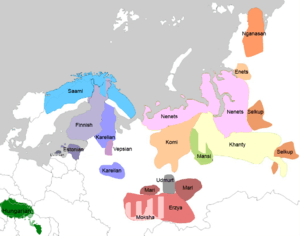
Russia's 185 ethnic groups speak over 100 languages.[16] According to the 2002 Census, 142.6 million people speak Russian, followed by Tatar with 5.3 million and Ukrainian with 1.8 million speakers.[347] Russian is the only official state language, but the Constitution gives the individual republics the right to establish their own state languages in addition to Russian.[348] Despite its wide distribution, the Russian language is homogeneous throughout the country. Russian is the most geographically widespread language of Eurasia, as well as the most widely spoken Slavic language.[349] It belongs to the Indo-European language family and is one of the living members of the East Slavic languages, the others being Belarusian and Ukrainian (and possibly Rusyn). Written examples of Old East Slavic (Old Russian) are attested from the 10th century onwards.[350]
Russian is the second-most used language on the Internet after English,[351] one of two official languages aboard the International Space Station[352] and is one of the six official languages of the UN.[353] 35 languages are officially recognised in Russia in various regions by local governments.

Religion
Though a secular state under the constitution, Russia is often said to have Russian Orthodoxy as the de facto national religion, despite other minorities: "The Russian Orthodox Church is de facto privileged religion of the state, claiming the right to decide which other religions or denominations are to be granted the right of registration".[377][378][379][380][381][382][383]
Russians have practised Orthodox Christianity since the 10th century. According to the historical traditions of the Orthodox Church, Christianity was first brought to the territory of modern Belarus, Russia and Ukraine by Saint Andrew, the first Apostle of Jesus Christ.[384] Following the Primary Chronicle, the definitive Christianization of Kievan Rus' dates from the year 988 (the year is disputed[385]), when Vladimir the Great was baptised in Chersonesus and proceeded to baptise his family and people in Kiev. The latter events are traditionally referred to as the "baptism of Rus'" (Russian: Крещение Руси, Ukrainian: Хрещення Русі) in Russian and Ukrainian literature. Much of the Russian population, like other Slavic peoples, preserved for centuries a double belief (dvoeverie) in both indigenous religion and Orthodox Christianity.
At the time of the 1917 Revolution, the Russian Orthodox Church was deeply integrated into the autocratic state, enjoying official status. This was a significant factor that contributed to the Bolshevik attitude to religion and the steps they took to control it. Moreover, the Bolsheviks including many people with non-Russian and/or non-Christian background, such as Vladimir Lenin, Leon Trotsky, Grigory Zinoviev, Lev Kamenev, and Grigori Sokolnikov, who were, at best, indifferent towards Christianity, and at worst hostile to it. The ideas of German philosopher Karl Marx were synthesised with Lenin's own political thought to form the Communist Party.[386]
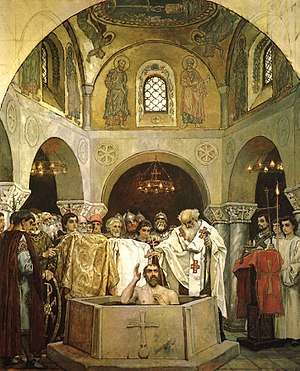
Thus the USSR became one of the first communist states to proclaim, as an ideological objective, the elimination of religion[387] and its replacement with universal atheism.[388][389] The communist government ridiculed religions and their believers, and propagated atheism in schools.[390] The confiscation of religious assets was often based on accusations of illegal accumulation of wealth. State atheism in the Soviet Union was known in Russian as gosateizm,[387] and was based on the ideology of Marxism–Leninism, which consistently advocated has consistently advocated the control, suppression, and elimination of religion. Within about a year of the revolution, the state expropriated all church property, including the churches themselves, and in the period from 1922 to 1926, 28 Russian Orthodox bishops and more than 1,200 priests were killed. Many more were persecuted.[391]
After the collapse of the Soviet Union there has been a renewal of religions in Russia, and among Slavs various movements have emerged besides Christianity, including Rodnovery (Slavic Native Faith), Assianism, and other ethnic Paganisms, Roerichism, Ringing Cedars' Anastasianism, Hinduism,[392] Siberian shamanism[393] or Tengrism, and other religions.
As of a different sociological surveys on religious adherence, from 41% to over 80% of the total population of Russia adhere to the Russian Orthodox Church.[394][395][396][397][398] In 2012 the research organization Sreda, in cooperation with the 2010 census and the Ministry of Justice, published the Arena Atlas, a detailed enumeration of religious populations and nationalities in Russia, based on a large-sample country-wide survey. The results showed that 46.8% of Russians declared themselves Christians—including 41% Russian Orthodox, 1.5% simply Orthodox or members of non-Russian Orthodox churches, 4.1% unaffiliated Christians, and less than 1% for both Old Believers, Catholics, and Protestants—while 25% were spiritual but not religious, 13% were atheists, 6.5% were Muslims, 1.2% were followers of "traditional religions honoring gods and ancestors" (including Rodnovery, Tengrism and other ethnic religions), and 0.5% were Buddhists, 0.1% were religious Jews and 0.1% were Hindus.[394]
The 2017 Survey Religious Belief and National Belonging in Central and Eastern Europe made by the Pew Research Center showed that 73% of Russians declared themselves Christians—including 71% Orthodox, 1% Catholic, and 2% Other Christians, while 15% were unaffiliated, 10% were Muslims, and 1% were from other religions.[375] According to the same study, Christianity experienced significant increase since the fall of the USSR in 1991,[399] and more Russians say they are Christian now (73%) than say they were raised Christian (65%).[399]
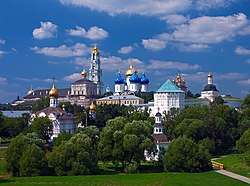
According to various reports, the proportion of not religious people in Russia is between 16% and 48% of the population.[400] According to recent studies, the proportion of atheists has significantly decreased over the decades after the dissolution of the Soviet Union.[401][402]
Orthodox Christianity, Islam, Buddhism, and Paganism (either preserved or revived) are recognised by law as Russia's traditional religions, marking the country's "historical heritage".[403][404]
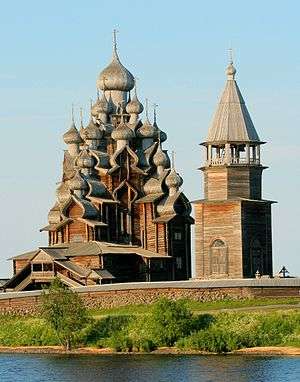
An estimated 95% of the registered Orthodox parishes belong to the Russian Orthodox Church while there are a number of smaller Orthodox churches.[405] However, the vast majority of Orthodox believers do not attend church on a regular basis. Easter is the most popular religious holiday in Russia, celebrated by a large segment of the Russian population, including large numbers of those who are non-religious. More than three-quarters of the Russian population celebrate Easter by making traditional Easter cakes, coloured eggs and paskha.[406]
Islam is the second largest religion in Russia after Russian Orthodoxy.[407] It is the traditional or predominant religion amongst some Caucasian ethnicities (notably the Chechens, the Ingush and the Circassians), and amongst some Turkic peoples (notably the Tatars and the Bashkirs). Survey published in 2019 by the Pew Research Center found that 76% of Russians had a favourable view of Muslims.[408]
Buddhism is traditional in three republics of Russia: Buryatia, Tuva, and Kalmykia, the latter being the only region in Europe where Buddhism is the most practiced religion.
In cultural and social affairs, Vladimir Putin has collaborated closely with the Russian Orthodox Church. Patriarch Kirill of Moscow, head of the Church, endorsed his election in 2012. Steven Myers reports, "The church, once heavily repressed, had emerged from the Soviet collapse as one of the most respected institutions... Now Kiril led the faithful directly into an alliance with the state."[409] Baptist minister Mark Woods provides specific examples of how the Church under Patriarch Kirill of Moscow has backed the expansion of Russian power into Crimea and eastern Ukraine.[410]
The Holy Synod of the Russian Orthodox Church, at its session on 15 October 2018, severed ties with the Ecumenical Patriarchate of Constantinople. The decision was taken in response to the move made by the Patriarchate of Constantinople a few days prior that effectively ended the Moscow Patriarchate's jurisdiction over Ukraine and promised autocephaly to Ukraine.[411][412]
On 26 April 2017, for the first time, the U.S. Commission on International Religious Freedom classified Russia as one of the world's worst violators of religious liberty, recommending in its 2017 annual report that the U.S. government deem Russia a "country of particular concern" under the International Religious Freedom Act and negotiate for religious liberty. The report states, "—it is the sole state to have not only continually intensified its repression of religious freedom since USCIRF commenced monitoring it, but also to have expanded its repressive policies....ranging from administrative harassment to arbitrary imprisonment to extrajudicial killing, are implemented in a fashion that is systematic, ongoing, and egregious."[413] On 4 April 2017 UN Special Rapporteur on Freedom of Opinion and Expression David Kaye, UN Special Rapporteur on Freedoms of Peaceful Assembly and Association Maina Kiai, and UN Special Rapporteur on Freedom of Religion and Belief Ahmed Shaheed condemned Russia's treatment of Jehovah's Witnesses.[414] Many other countries and international organizations have spoken out on Russia's religious abuses.[415][416]
Health
The Russian Constitution guarantees free, universal health care for all its citizens.[417] In practice, however, free health care is partially restricted because of mandatory registration.[418] While Russia has more physicians, hospitals, and health care workers than almost any other country in the world on a per capita basis,[419] since the dissolution of the Soviet Union the health of the Russian population has declined considerably as a result of social, economic, and lifestyle changes;[420] the trend has been reversed only in the recent years, with average life expectancy having increased 6.8 years for males and 4.2 years for females between 2006 and 2018.[421]
Due to the ongoing Russian financial crisis since 2014, major cuts in health spending have resulted in a decline in the quality of service of the state healthcare system. About 40% of basic medical facilities have fewer staff than they are supposed to have, with others being closed down. Waiting times for treatment have increased, and patients have been forced to pay for more services that were previously free.[422][423]
As of 2018, the average life expectancy at birth in Russia is 72.4 years (66.9 years for males and 77.6 years for females).[421] The biggest factor contributing to the relatively low life expectancy for males is a high mortality rate among working-age males. Deaths mostly occur from preventable causes, including alcohol poisoning, smoking, traffic accidents and violent crime.[321] As a result, Russia has one of the world's most female-biased sex ratios, with 0.859 males to every female.[125]
Education
Russia has the most college-level or higher graduates in terms of percentage of population in the world, at 54%.[424] Russia has a free education system, which is guaranteed for all citizens by the Constitution,[425] however entry to subsidised higher education is highly competitive.[426] As a result of great emphasis on science and technology in education, Russian medical, mathematical, scientific, and aerospace research is generally of a high order.[427]
Since 1990, the 11-year school education has been introduced. Education in state-owned secondary schools is free. University level education is free, with exceptions. A substantial share of students is enrolled for full pay (many state institutions started to open commercial positions in the last years).[428]
The oldest and largest Russian universities are Moscow State University and Saint Petersburg State University. In the 2000s, in order to create higher education and research institutions of comparable scale in Russian regions, the government launched a program of establishing "federal universities", mostly by merging existing large regional universities and research institutes and providing them with a special funding. These new institutions include the Southern Federal University, Siberian Federal University, Kazan Volga Federal University, North-Eastern Federal University, and Far Eastern Federal University. According to the 2018 QS World University Rankings, the highest-ranking Russian educational institution is Moscow State University, rated 95th in the world.
Culture
Folk culture and cuisine
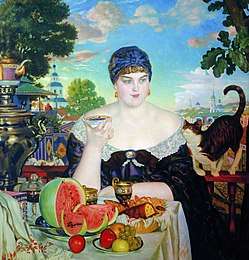
There are over 160 different ethnic groups and indigenous peoples in Russia.[324] The country's vast cultural diversity spans ethnic Russians with their Slavic Orthodox traditions, Tatars and Bashkirs with their Turkic Muslim culture, Buddhist nomadic Buryats and Kalmyks, Shamanistic peoples of the Extreme North and Siberia, highlanders of the Northern Caucasus, and Finno-Ugric peoples of the Russian North West and Volga Region.
Handicraft, like Dymkovo toy, khokhloma, gzhel and palekh miniature represent an important aspect of Russian folk culture. Ethnic Russian clothes include kaftan, kosovorotka and ushanka for men, sarafan and kokoshnik for women, with lapti and valenki as common shoes. The clothes of Cossacks from Southern Russia include burka and papaha, which they share with the peoples of the Northern Caucasus.
Russian cuisine widely uses fish, caviar, poultry, mushrooms, berries, and honey. Crops of rye, wheat, barley, and millet provide the ingredients for various breads, pancakes and cereals, as well as for kvass, beer and vodka drinks. Black bread is rather popular in Russia, compared to the rest of the world. Flavourful soups and stews include shchi, borsch, ukha, solyanka and okroshka. Smetana (a heavy sour cream) is often added to soups and salads. Pirozhki, blini and syrniki are native types of pancakes. Chicken Kiev, pelmeni and shashlyk are popular meat dishes, the last two being of Tatar and Caucasus origin respectively. Other meat dishes include stuffed cabbage rolls (golubtsy) usually filled with meat.[429] Salads include Olivier salad, vinegret and dressed herring.
Russia's large number of ethnic groups have distinctive traditions regarding folk music. Typical ethnic Russian musical instruments are gusli, balalaika, zhaleika, and garmoshka. Folk music had a significant influence on Russian classical composers, and in modern times it is a source of inspiration for a number of popular folk bands, like Melnitsa. Russian folk songs, as well as patriotic Soviet songs, constitute the bulk of the repertoire of the world-renowned Red Army choir and other popular ensembles.
Russians have many traditions, including the washing in banya, a hot steam bath somewhat similar to sauna.[66] Old Russian folklore takes its roots in the pagan Slavic religion. Many Russian fairy tales and epic bylinas were adapted for animation films, or for feature movies by the prominent directors like Aleksandr Ptushko (Ilya Muromets, Sadko) and Aleksandr Rou (Morozko, Vasilisa the Beautiful). Russian poets, including Pyotr Yershov and Leonid Filatov, made a number of well-known poetical interpretations of the classical fairy tales, and in some cases, like that of Alexander Pushkin, also created fully original fairy tale poems of great popularity.
Architecture

Since the Christianization of Kievan Rus' for several ages Russian architecture was influenced predominantly by the Byzantine architecture. Apart from fortifications (kremlins), the main stone buildings of ancient Rus' were Orthodox churches with their many domes, often gilded or brightly painted.
Aristotle Fioravanti and other Italian architects brought Renaissance trends into Russia since the late 15th century, while the 16th century saw the development of unique tent-like churches culminating in Saint Basil's Cathedral.[430] By that time the onion dome design was also fully developed.[431] In the 17th century, the "fiery style" of ornamentation flourished in Moscow and Yaroslavl, gradually paving the way for the Naryshkin baroque of the 1690s. After the reforms of Peter the Great the change of architectural styles in Russia generally followed that in the Western Europe.
The 18th-century taste for rococo architecture led to the ornate works of Bartolomeo Rastrelli and his followers. The reigns of Catherine the Great and her grandson Alexander I saw the flourishing of Neoclassical architecture, most notably in the capital city of Saint Petersburg. The second half of the 19th century was dominated by the Neo-Byzantine and Russian Revival styles. Prevalent styles of the 20th century were the Art Nouveau, Constructivism, and the Stalin Empire style.
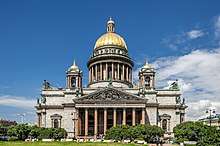
With the change in values imposed by communist ideology, the tradition of preservation was broken. Independent preservation societies, even those that defended only secular landmarks such as Moscow-based OIRU were disbanded by the end of the 1920s. A new anti-religious campaign, launched in 1929, coincided with collectivization of peasants; destruction of churches in the cities peaked around 1932. A number of churches were demolished, including the Cathedral of Christ the Saviour in Moscow. In Moscow alone losses of 1917–2006 are estimated at over 640 notable buildings (including 150 to 200 listed buildings, out of a total inventory of 3,500) – some disappeared completely, others were replaced with concrete replicas.
In 1955, a new Soviet leader, Nikita Khrushchev, condemned the "excesses" of the former academic architecture,[432] and the late Soviet era was dominated by plain functionalism in architecture. This helped somewhat to resolve the housing problem, but created a large quantity of buildings of low architectural quality, much in contrast with the previous bright styles. In 1959 Nikita Khrushchev launched his anti-religious campaign. By 1964 over 10 thousand churches out of 20 thousand were shut down (mostly in rural areas) and many were demolished. Of 58 monasteries and convents operating in 1959, only sixteen remained by 1964; of Moscow's fifty churches operating in 1959, thirty were closed and six demolished.
Visual arts
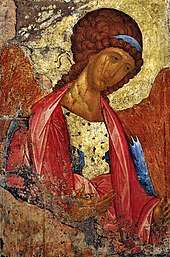
Early Russian painting is represented in icons and vibrant frescos, the two genres inherited from Byzantium. As Moscow rose to power, Theophanes the Greek, Dionisius and Andrei Rublev became vital names associated with a distinctly Russian art.
The Russian Academy of Arts was created in 1757[433] and gave Russian artists an international role and status. Ivan Argunov, Dmitry Levitzky, Vladimir Borovikovsky and other 18th-century academicians mostly focused on portrait painting. In the early 19th century, when neoclassicism and romantism flourished, mythological and Biblical themes inspired many prominent paintings, notably by Karl Briullov and Alexander Ivanov.
In the mid-19th century the Peredvizhniki (Wanderers) group of artists broke with the Academy and initiated a school of art liberated from academic restrictions.[434] These were mostly realist painters who captured Russian identity in landscapes of wide rivers, forests, and birch clearings, as well as vigorous genre scenes and robust portraits of their contemporaries. Some artists focused on depicting dramatic moments in Russian history, while others turned to social criticism, showing the conditions of the poor and caricaturing authority; critical realism flourished under the reign of Alexander II. Leading realists include Ivan Shishkin, Arkhip Kuindzhi, Ivan Kramskoi, Vasily Polenov, Isaac Levitan, Vasily Surikov, Viktor Vasnetsov, Ilya Repin, and Boris Kustodiev.
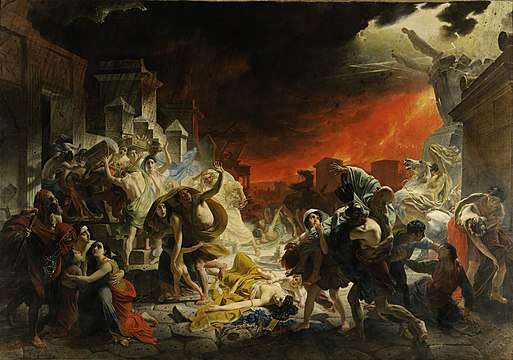
The turn of the 20th century saw the rise of symbolist painting, represented by Mikhail Vrubel, Kuzma Petrov-Vodkin, and Nicholas Roerich.
The Russian avant-garde was a large, influential wave of modernist art that flourished in Russia from approximately 1890 to 1930. The term covers many separate, but inextricably related art movements that occurred at the time, namely neo-primitivism, suprematism, constructivism, rayonism, and Russian Futurism. Notable artists from this era include El Lissitzky, Kazimir Malevich, Wassily Kandinsky, and Marc Chagall. Since the 1930s the revolutionary ideas of the avant-garde clashed with the newly emerged conservative direction of socialist realism.
Soviet art produced works that were furiously patriotic and anti-fascist during and after the Great Patriotic War. Multiple war memorials, marked by a great restrained solemnity, were built throughout the country. Soviet artists often combined innovation with socialist realism, notably the sculptors Vera Mukhina, Yevgeny Vuchetich and Ernst Neizvestny.
Music and dance
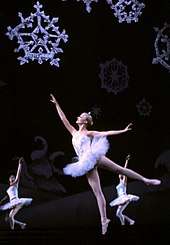
Music in 19th-century Russia was defined by the tension between classical composer Mikhail Glinka along with other members of The Mighty Handful, who embraced Russian national identity and added religious and folk elements to their compositions, and the Russian Musical Society led by composers Anton and Nikolay Rubinsteins, which was musically conservative. The later tradition of Pyotr Ilyich Tchaikovsky, one of the greatest composers of the Romantic era, was continued into the 20th century by Sergei Rachmaninoff.[435] World-renowned composers of the 20th century include Alexander Scriabin, Igor Stravinsky, Sergei Prokofiev, Dmitri Shostakovich and Alfred Schnittke.
Russian conservatories have turned out generations of famous soloists. Among the best known are violinists Jascha Heifetz, David Oistrakh, Leonid Kogan, Gidon Kremer, and Maxim Vengerov; cellists Mstislav Rostropovich, Natalia Gutman; pianists Vladimir Horowitz, Sviatoslav Richter, Emil Gilels, Vladimir Sofronitsky and Evgeny Kissin; and vocalists Fyodor Shalyapin, Mark Reizen, Elena Obraztsova, Tamara Sinyavskaya, Nina Dorliak, Galina Vishnevskaya, Anna Netrebko and Dmitry Hvorostovsky.[436]
During the early 20th century, Russian ballet dancers Anna Pavlova and Vaslav Nijinsky rose to fame, and impresario Sergei Diaghilev and his Ballets Russes' travels abroad profoundly influenced the development of dance worldwide.[437] Soviet ballet preserved the perfected 19th-century traditions,[438] and the Soviet Union's choreography schools produced many internationally famous stars, including Galina Ulanova, Maya Plisetskaya, Rudolf Nureyev, and Mikhail Baryshnikov. The Bolshoi Ballet in Moscow and the Mariinsky Ballet in St Petersburg remain famous throughout the world.[439]
Modern Russian rock music takes its roots both in the Western rock and roll and heavy metal, and in traditions of the Russian bards of the Soviet era, such as Vladimir Vysotsky and Bulat Okudzhava.[440] Popular Russian rock groups include Mashina Vremeni, DDT, Aquarium, Alisa, Kino, Kipelov, Nautilus Pompilius, Aria, Grazhdanskaya Oborona, Splean, and Korol i Shut. Russian pop music developed from what was known in the Soviet times as estrada into full-fledged industry, with some performers gaining wide international recognition, such as t.A.T.u., Nu Virgos and Vitas.
Literature and philosophy
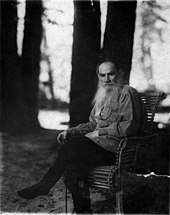
In the 18th century, during the era of Russian Enlightenment, the development of Russian literature was boosted by the works of Mikhail Lomonosov and Denis Fonvizin. By the early 19th century a modern national tradition had emerged, producing some of the greatest writers in Russian history. This period, known also as the Golden Age of Russian Poetry, began with Alexander Pushkin, who is considered the founder of the modern Russian literary language and often described as the "Russian Shakespeare".[441] It continued with the poetry of Mikhail Lermontov and Nikolay Nekrasov, dramas of Alexander Ostrovsky and Anton Chekhov, and the prose of Nikolai Gogol and Ivan Turgenev. Leo Tolstoy and Fyodor Dostoyevsky have been described by literary critics as the greatest novelists of all time.[442][443]
By the 1880s, the age of the great novelists was over, and short fiction and poetry became the dominant genres. The next several decades became known as the Silver Age of Russian Poetry, when the previously dominant literary realism was replaced by symbolism. Leading authors of this era include such poets as Valery Bryusov, Vyacheslav Ivanov, Alexander Blok, Nikolay Gumilev and Anna Akhmatova, and novelists Leonid Andreyev, Ivan Bunin, and Maxim Gorky.
Russian philosophy blossomed in the 19th century, when it was defined initially by the opposition of Westernisers, who advocated Western political and economical models, and Slavophiles, who insisted on developing Russia as a unique civilization. The latter group includes Nikolai Danilevsky and Konstantin Leontiev, the founders of eurasianism. In its further development Russian philosophy was always marked by a deep connection to literature and interest in creativity, society, politics and nationalism; Russian cosmism and religious philosophy were other major areas. Notable philosophers of the late 19th and the early 20th centuries include Vladimir Solovyev, Sergei Bulgakov, and Vladimir Vernadsky.
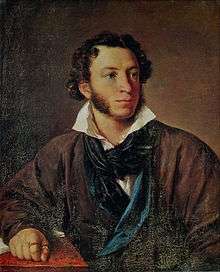
Following the Russian Revolution of 1917 many prominent writers and philosophers left the country, including Bunin, Vladimir Nabokov and Nikolay Berdyayev, while a new generation of talented authors joined together in an effort to create a distinctive working-class culture appropriate for the new Soviet state. In the 1930s censorship over literature was tightened in line with the policy of socialist realism. In the late 1950s restrictions on literature were eased, and by the 1970s and 1980s, writers were increasingly ignoring official guidelines. Leading authors of the Soviet era include novelists Yevgeny Zamyatin (emigrated), Ilf and Petrov, Mikhail Bulgakov (censored) and Mikhail Sholokhov, and poets Vladimir Mayakovsky, Yevgeny Yevtushenko, and Andrey Voznesensky.
The Soviet Union was also a major producer of science fiction, written by authors like Arkady and Boris Strugatsky, Kir Bulychov, Alexander Belayev and Ivan Yefremov.[444] Traditions of Russian science fiction and fantasy are continued today by numerous writers.
Cinema, animation and media
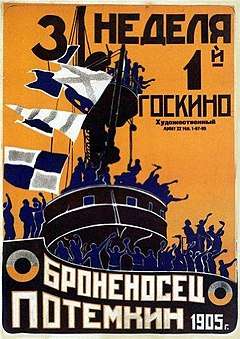
Russian and later Soviet cinema was a hotbed of invention in the period immediately following 1917, resulting in world-renowned films such as The Battleship Potemkin by Sergei Eisenstein.[445] Eisenstein was a student of filmmaker and theorist Lev Kuleshov, who developed the Soviet montage theory of film editing at the world's first film school, the All-Union Institute of Cinematography. Dziga Vertov, whose kino-glaz ("film-eye") theory—that the camera, like the human eye, is best used to explore real life—had a huge impact on the development of documentary film making and cinema realism. The subsequent state policy of socialist realism somewhat limited creativity; however, many Soviet films in this style were artistically successful, including Chapaev, The Cranes Are Flying, and Ballad of a Soldier.[445]
The 1960s and 1970s saw a greater variety of artistic styles in Soviet cinema. Eldar Ryazanov's and Leonid Gaidai's comedies of that time were immensely popular, with many of the catch phrases still in use today. In 1961–68 Sergey Bondarchuk directed an Oscar-winning film adaptation of Leo Tolstoy's epic War and Peace, which was the most expensive film made in the Soviet Union.[446] In 1969, Vladimir Motyl's White Sun of the Desert was released, a very popular film in a genre of ostern; the film is traditionally watched by cosmonauts before any trip into space.[447]

Russian animation dates back to late Russian Empire times. During the Soviet era, Soyuzmultfilm studio was the largest animation producer. Soviet animators developed a great variety of pioneering techniques and aesthetic styles, with prominent directors including Ivan Ivanov-Vano, Fyodor Khitruk and Aleksandr Tatarsky. Many Soviet cartoon heroes such as the Russian-style Winnie-the-Pooh, cute little Cheburashka, Wolf and Hare from Nu, Pogodi!, are iconic images in Russia and many surrounding countries.
The late 1980s and 1990s were a period of crisis in Russian cinema and animation. Although Russian filmmakers became free to express themselves, state subsidies were drastically reduced, resulting in fewer films produced. The early years of the 21st century have brought increased viewership and subsequent prosperity to the industry on the back of the economic revival. Production levels are already higher than in Britain and Germany.[448] Russia's total box-office revenue in 2007 was $565 million, up 37% from the previous year.[449] In 2002 the Russian Ark became the first feature film ever to be shot in a single take. The traditions of Soviet animation were developed recently by such directors as Aleksandr Petrov and studios like Melnitsa Animation.
While there were few stations or channels in the Soviet time, in the past two decades many new state and privately owned radio stations and TV channels have appeared. In 2005 a state-run English language Russia Today TV started broadcasting, and its Arabic version Rusiya Al-Yaum was launched in 2007. Censorship and Media freedom in Russia has always been a main theme of Russian media.
Sports
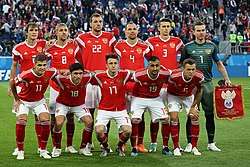
Soviet and later Russian athletes have always been in the top four for the number of gold medals collected at the Summer Olympics. Soviet gymnasts, track-and-field athletes, weightlifters, wrestlers, boxers, fencers, shooters, cross country skiers, biathletes, speed skaters and figure skaters were consistently among the best in the world, along with Soviet basketball, handball, volleyball and ice hockey players.[450] The 1980 Summer Olympics were held in Moscow while the 2014 Winter Olympics were hosted in Sochi.

Although ice hockey was only introduced during the Soviet era, the Soviet Union national team managed to win gold at almost all the Olympics and World Championships they contested. Russian players Valery Kharlamov, Sergei Makarov, Vyacheslav Fetisov and Vladislav Tretiak hold four of six positions in the IIHF Team of the Century.[451] Russia has not won the Olympic ice hockey tournament since the Unified Team won gold in 1992. Russia won the 1993, 2008, 2009,[452] 2012 and the 2014 IIHF World Championships.[453]
The Kontinental Hockey League (KHL) was founded in 2008 as a successor to the Russian Superleague. It is ranked the top hockey league in Europe as of 2009,[454] and the second-best in the world.[455] It is an international professional ice hockey league in Eurasia and consists of 29 teams, of which 21 are based in Russia and 7 more are located in Latvia, Kazakhstan, Belarus, Finland, Slovakia, Croatia and China. KHL is on the 4th place by attendance in Europe.[456]
Bandy, also known as Russian hockey, is another traditionally popular ice sport.[457] The Soviet Union won all the Bandy World Championships for men between 1957–79[458] and some thereafter too. After the dissolution of the Soviet Union, Russia has continuously been one of the most successful teams, winning many world championships.
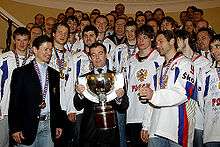
Association football is one of the most popular sports in modern Russia. The Soviet national team became the first European Champions by winning Euro 1960. Appearing in four FIFA World Cups from 1958 to 1970, Lev Yashin is regarded as one of the greatest goalkeepers in the history of football, and was chosen on the FIFA World Cup Dream Team.[459] The Soviet national team reached the finals of Euro 1988. In 1956 and 1988, the Soviet Union won gold at the Olympic football tournament. Russian clubs CSKA Moscow and Zenit St Petersburg won the UEFA Cup in 2005 and 2008. The Russian national football team reached the semi-finals of Euro 2008, losing only to the eventual champions Spain. Russia was the host nation for the 2018 FIFA World Cup. The matches were held from 14 June to 15 July 2018 in the stadiums of 11 host cities located in the European part of the country and in the Ural region.[460] This was the first football World Cup ever held in Eastern Europe, and the first held in Europe since 2006. Russia will also host games of Euro 2020.

In 2007, the Russian national basketball team won the European Basketball Championship. The Russian basketball club PBC CSKA Moscow is one of the top teams in Europe, winning the Euroleague in 2006 and 2008.
Larisa Latynina, who currently holds the record for the most gold Olympic medals won by a woman, established the USSR as the dominant force in gymnastics for many years.[461] Today, Russia is the leading nation in rhythmic gymnastics with Yevgeniya Kanayeva. Double 50 m and 100 m freestyle Olympic gold medalist Alexander Popov is widely considered the greatest sprint swimmer in history.[462] Russian synchronised swimming is the best in the world, with almost all gold medals at Olympics and World Championships having been swept by Russians in recent decades. Figure skating is another popular sport in Russia, especially pair skating and ice dancing. With the exception of 2010 and 2018 a Soviet or Russian pair has won gold at every Winter Olympics since 1964.
Since the end of the Soviet era, tennis has grown in popularity and Russia has produced a number of famous players, including Maria Sharapova. In martial arts, Russia produced the sport Sambo and renowned fighters, like Fedor Emelianenko. Chess is a widely popular pastime in Russia; from 1927, Russian grandmasters have held the world chess championship almost continuously.[463]
The 2014 Winter Olympics were held in Sochi in the south of Russia. In 2016 the McLaren Report found evidence of widespread state-sponsored doping and an institutional conspiracy to cover up Russian competitors' positive drug tests.[464] As of 1 December 2017 25 athletes are disqualified, 11 medals are stripped.
Formula One is also becoming increasingly popular in Russia. In 2010 Vitaly Petrov of Vyborg became the first Russian to drive in Formula One, and was soon followed by a second – Daniil Kvyat, from Ufa – in 2014. There had only been two Russian Grands Prix (in 1913 and 1914), but the Russian Grand Prix returned as part of the Formula One season in 2014, as part of a six-year deal.[465]
Russia has the most Olympic medals stripped for doping violations (51), the most of any country, four times the number of the runner-up, and more than a third of the global total, and 129 athletes caught doping at the Olympics, also the most of any country. From 2011 to 2015, more than a thousand Russian competitors in various sports, including summer, winter, and Paralympic sports, benefited from a state-sponsored cover-up,[466][467][468][469][470] with no indication that the program has ceased since then.[471]
National holidays and symbols

There are seven public holidays in Russia,[472] except those always celebrated on Sunday. Russian New Year traditions resemble those of the Western Christmas, with New Year Trees and gifts, and Ded Moroz (Father Frost) playing the same role as Santa Claus. Orthodox Christmas falls on 7 January, because the Russian Orthodox Church still follows the Julian calendar, and all Orthodox holidays are 13 days after Western ones. Two other major Christian holidays are Easter and Trinity Sunday. Kurban Bayram and Uraza Bayram are celebrated by Russian Muslims.
Further Russian public holidays include Defender of the Fatherland Day (23 February), which honors Russian men, especially those serving in the army; International Women's Day (8 March), which combines the traditions of Mother's Day and Valentine's Day; Spring and Labor Day (1 May); Victory Day (9 May); Russia Day (12 June); and Unity Day (4 November), commemorating the popular uprising which expelled the Polish occupation force from Moscow in 1612.
Victory Day is the second most popular holiday in Russia; it commemorates the victory over Nazi Germany and its allies in the Great Patriotic War. A huge military parade, hosted by the President of Russia, is annually organised in Moscow on Red Square. Similar parades take place in all major Russian cities and cities with the status Hero city or City of Military Glory.
Popular non-public holidays include Old New Year (the New Year according to the Julian Calendar on 14 January), Tatiana Day (students holiday on 25 January), Maslenitsa (a pre-Christian spring holiday a week before the Great Lent), Cosmonautics Day (in tribute to the first human trip into space), Ivan Kupala Day (another pre-Christian holiday on 7 July) and Peter and Fevronia Day (which takes place on 8 July and is the Russian analogue of Valentine's Day, focusing, however, on family love and fidelity).
.jpg)
State symbols of Russia include the Byzantine double-headed eagle, combined with St. George of Moscow in the Russian coat of arms. The Russian flag dates from the late Tsardom of Russia period and has been widely used since the time of the Russian Empire. The Russian anthem shares its music with the Soviet Anthem, though not the lyrics. The imperial motto God is with us and the Soviet motto Proletarians of all countries, unite! are now obsolete and no new motto has replaced them. The hammer and sickle and the full Soviet coat of arms are still widely seen in Russian cities as a part of old architectural decorations. The Soviet Red Stars are also encountered, often on military equipment and war memorials. The Red Banner continues to be honored, especially the Banner of Victory of 1945.
The Matryoshka doll is a recognizable symbol of Russia, and the towers of Moscow Kremlin and Saint Basil's Cathedral in Moscow are Russia's main architectural icons. Cheburashka is a mascot of the Russian national Olympic team. St. Mary, St. Nicholas, St. Andrew, St. George, St. Alexander Nevsky, St. Sergius of Radonezh and St. Seraphim of Sarov are Russia's patron saints. Chamomile is the national flower, while birch is the national tree. The Russian bear is an animal symbol and Mother Russia a national personification of Russia, though the bear image has a Western origin and Russians themselves have accepted it only fairly recently.
Tourism
.jpg)
Tourism in Russia has seen rapid growth since the late Soviet period, first domestic tourism and then international tourism, fueled by the rich cultural heritage and great natural variety of the country. Major tourist routes in Russia include a journey around the Golden Ring theme route of ancient cities, cruises on the big rivers like the Volga, and long journeys on the famous Trans-Siberian Railway. In 2013, Russia was visited by 28.4 million tourists; it is the ninth-most visited country in the world and the seventh-most visited in Europe.[473] The number of Western visitors dropped in 2014.[474]
The most visited destinations in Russia are Moscow and Saint Petersburg, the current and former capitals of the country. Recognised as World Cities, they feature such world-renowned museums as the Tretyakov Gallery and the Hermitage, famous theaters like Bolshoi and Mariinsky, ornate churches like Saint Basil's Cathedral, Cathedral of Christ the Saviour, Saint Isaac's Cathedral and Church of the Savior on Blood, impressive fortifications like the Kremlin and Peter and Paul Fortress, beautiful squares and streets like Red Square, Palace Square, Tverskaya Street, Nevsky Prospect, and Arbat Street. Rich palaces and parks are found in the former imperial residences in suburbs of Moscow (Kolomenskoye, Tsaritsyno) and St Petersburg (Peterhof, Strelna, Oranienbaum, Gatchina, Pavlovsk and Tsarskoye Selo). Moscow displays Soviet architecture at its best, along with modern skyscrapers, while St Petersburg, nicknamed Venice of the North, boasts of its classical architecture, many rivers, canals and bridges.
Kazan, the capital of Tatarstan, shows a mix of Christian Russian and Muslim Tatar cultures. The city has registered a brand The Third Capital of Russia, though a number of other major cities compete for this status, including Novosibirsk, Yekaterinburg and Nizhny Novgorod.
The warm subtropical Black Sea coast of Russia is the site for a number of popular sea resorts, like Sochi, the follow-up host of the 2014 Winter Olympics. The mountains of the Northern Caucasus contain popular ski resorts such as Dombay. The most famous natural destination in Russia is Lake Baikal, the Blue Eye of Siberia. This unique lake, the oldest and deepest in the world, has crystal-clear waters and is surrounded by taiga-covered mountains. Other popular natural destinations include Kamchatka with its volcanoes and geysers, Karelia with its lakes and granite rocks, the snowy Altai Mountains, and the wild steppes of Tuva.
See also
- Outline of Russia
- Index of Soviet Union-related articles
Notes
- Russian-annexed Crimea, is still internationally recognized as part of Ukraine that is[1] shown in light green.[2]
- Russian-annexed Crimea, is still internationally recognized as part of Ukraine that is[3] shown in light green.[4]
- When including the Republic of Crimea and Sevastopol, the total area of Russia rises to 17,125,191 km2 (6,612,073 sq mi)[9]
- Russian: Росси́йская Федера́ция, tr. Rossiyskaya Federatsiya, IPA: [rɐˈsʲijskəjə fʲɪdʲɪˈratsɨjə]
- Kaliningrad Oblast is an exclave of the Russian Federation on the Baltic Sea, which is geographically located in Central Europe, while the main portion of European Russia is in Eastern Europe.
- Annexed by Russia in 2014 Voted to join Russian Federation in 2014; recognised as a part of Ukraine by most of the international community.
References
- "Republic of Crimea". The Territories of the Russian Federation 2020. Routledge. 2020. ISBN 9781003007067.
Note: The territories of the Crimean peninsula, comprising Sevastopol City and the Republic of Crimea, remained internationally recognized as constituting part of Ukraine, following their annexation by Russia in March 2014.
- Taylor, Adam (22 March 2014). "Crimea has joined the ranks of the world's 'gray areas.' Here are the others on that list". The Washington Post. Retrieved 27 March 2014.
- "Republic of Crimea". The Territories of the Russian Federation 2020. Routledge. 2020. ISBN 9781003007067.
Note: The territories of the Crimean peninsula, comprising Sevastopol City and the Republic of Crimea, remained internationally recognized as constituting part of Ukraine, following their annexation by Russia in March 2014.
- Taylor, Adam (22 March 2014). "Crimea has joined the ranks of the world's 'gray areas.' Here are the others on that list". The Washington Post. Retrieved 27 March 2014.
- "ВПН-2010". perepis-2010.ru. Archived from the original on 18 January 2012.
- "Religious Belief and National Belonging in Central and Eastern Europe". Pew Research Center. 10 May 2017. Retrieved 9 September 2017.
- s:Constitution of Russia
- "World Statistics Pocketbook 2016 edition" (PDF). United Nations Department of Economic and Social Affairs. Statistics Division. Retrieved 24 April 2018.
- "Information about availability and distribution of land in the Russian Federation as of 1 January 2017 (by federal subjects of Russia)" Сведения о наличии и распределении земель в Российской Федерации на 1 January 2017 (в разрезе субъектов Российской Федерации). Rosreestr.
- "The Russian federation: general characteristics". Federal State Statistics Service. Archived from the original on 28 July 2011. Retrieved 5 April 2008.
- Оценка численности постоянного населения на 1 января 2020 года и в среднем за 2019 год [Estimated population as of 1 January 2020 and on the average for 2019] (XLS). Russian Federal State Statistics Service (in Russian). Retrieved 21 June 2020.
- "World Economic Outlook Database, October 2019". IMF.org. International Monetary Fund. Retrieved 18 January 2020.
- "GINI index (World Bank estimate) – Russian Federation". World Bank. Retrieved 22 March 2020.
- "Human Development Report 2019" (PDF). United Nations Development Programme. 10 December 2019. Retrieved 10 December 2019.
- "The Constitution of the Russian Federation". (Article 1). Retrieved 25 June 2009.
The names 'Russian Federation' and 'Russia' shall be equal.
- "Russia". Encyclopædia Britannica. Retrieved 31 January 2008.
- "General Information". Russian Embassy, Washington DC.
- "Территория и население Российской Федерации". Archived from the original on 16 April 2016.
- "Рекорды и антирекорды России". Archived from the original on 9 March 2016. Retrieved 4 February 2019.
- "European Countries by population (2020)".
- "Countries in the world by population (2020)".
- "Russia". Encyclopædia Britannica. Retrieved 31 January 2008.
- Excerpted from Glenn E. Curtis (ed.) (1998). "Russia: A Country Study: Kievan Rus' and Mongol Periods". Washington, D.C.: Federal Research Division of the Library of Congress. Archived from the original on 27 September 2007. Retrieved 20 July 2007.CS1 maint: extra text: authors list (link)
- Chaliand, Gérard (1967). Introduction. The Mongol Empire: Its Rise and Legacy. By Prawdin, Michael. Transaction Publishers. pp. 512–550. ISBN 978-1-4128-2897-0.
- Rein Taagepera (1997). "Expansion and Contraction Patterns of Large Polities: Context for Russia". International Studies Quarterly. 41 (3): 475–504. doi:10.1111/0020-8833.00053.
- Peter Turchin; Thomas D. Hall; Jonathan M. Adams (2006). "East-West Orientation of Historical Empires" (PDF). Journal of World-Systems Research, Vol. 12 (no. 2). pp. 219–229. Archived from the original (PDF) on 22 February 2007.
- Jonathan R. Adelman; Cristann Lea Gibson (1 July 1989). Contemporary Soviet Military Affairs: The Legacy of World War II. Unwin Hyman. p. 4. ISBN 978-0-04-445031-3. Retrieved 15 June 2012.
- Weinberg, G. L. (1995). A World at Arms: A Global History of World War II. Cambridge University Press. p. 264. ISBN 978-0-521-55879-2.
- Rozhnov, Konstantin, "Who won World War II?". BBC.
- "Country Profile: Russia". Foreign & Commonwealth Office of the United Kingdom. Archived from the original on 16 October 2009. Retrieved 27 December 2007.
- "Putin says Russia has to be strong presidential republic". Reuters.
- Cheung, Helier (28 June 2019). "Is Putin right? Is liberalism really dead?". BBC News. Retrieved 29 February 2020.
- Foy, Henry; Barker, Alex; Barber, Lionel (27 June 2019). "Vladimir Putin says liberalism has 'become obsolete'". www.ft.com. Retrieved 29 February 2020.
- "Transcript: 'All this fuss about spies ... it is not worth serious interstate relations'". Financial Times. 27 June 2019. Retrieved 29 February 2020.
- "World Economic Outlook Database, October 2019". IMF.org. International Monetary Fund. Retrieved 18 January 2020.
- "Commission of the Russian Federation for UNESCO: Panorama of Russia". Unesco.ru. Retrieved 29 October 2010.
- "International Energy Agency – Oil Market Report" (PDF). 18 January 2012. Archived from the original (PDF) on 18 May 2012. Retrieved 20 February 2012.
- "Country Comparison :: Natural gas – production", CIA World Factbook. Retrieved 3 February 2014.
- "Status of World Nuclear Forces – Federation Of American Scientists". Fas.org. Retrieved 27 March 2020.
- Centre, UNESCO World Heritage. "UNESCO World Heritage Centre – World Heritage List". whc.unesco.org. Retrieved 3 July 2018.
- International Tourism Highlights, 2019 Edition. 2019. doi:10.18111/9789284421152. ISBN 9789284421152.
- "Strengthened ASEAN-Russian military links are a signal Russia is serious about its pivot to Asia". www.aseantoday.com.
- Desk, Devdiscourse News. "Russia and ASEAN reaffirm to deepen their partnership | Global Edition". Devdiscourse.
- "ASEAN – Russia". en.russia-asean20.ru.
- "Online Etymology Dictionary". Etymonline.com. Retrieved 2 November 2011.
- "Rus – definition of Rus by the Free Online Dictionary, Thesaurus and Encyclopedia". Thefreedictionary.com. Retrieved 2 November 2011.
- Milner-Gulland, R. R. (1997). The Russians: The People of Europe. Blackwell Publishing. pp. 1–4. ISBN 978-0-631-21849-4. Retrieved 15 December 2016.
- "Definition of Russian". Merriam-Webster. Retrieved 21 September 2016.
- Belinskij A, Härke, H (1999). "The 'Princess' of Ipatovo". Archeology. 52 (2). Archived from the original on 10 June 2008. Retrieved 26 December 2007.CS1 maint: multiple names: authors list (link)
- Jacobson, E. (1995). The Art of the Scythians: The Interpenetration of Cultures at the Edge of the Hellenic World. Brill. p. 38. ISBN 978-90-04-09856-5.
- Tsetskhladze, G. R. (1998). The Greek Colonisation of the Black Sea Area: Historical Interpretation of Archaeology. F. Steiner. p. 48. ISBN 978-3-515-07302-8.
- Turchin, P. (2003). Historical Dynamics: Why States Rise and Fall. Princeton University Press. pp. 185–186. ISBN 978-0-691-11669-3.
- Christian, D. (1998). A History of Russia, Central Asia and Mongolia. Blackwell Publishing. pp. 286–288. ISBN 978-0-631-20814-3.
- For a discussion of the origins of Slavs, see Barford, P. M. (2001). The Early Slavs. Cornell University Press. pp. 15–16. ISBN 978-0-8014-3977-3.CS1 maint: multiple names: authors list (link)
- Christian, D. (1998). A History of Russia, Central Asia and Mongolia. Blackwell Publishing. pp. 6–7.
- Obolensky, D. (1994). Byzantium and the Slavs. St Vladimir's Seminary Press. p. 42. ISBN 978-0-88141-008-2.
- Thompson, J.W.; Johnson, E.N. (1937). An Introduction to Medieval Europe, 300–1500. W. W. Norton & Co. p. 268. ISBN 978-0-415-34699-3.
- "Ukraine: Security Assistance". U.S. Department of State. Retrieved 27 December 2007.
- Klyuchevsky, V. (1987). The course of the Russian history. 1. Myslʹ. ISBN 978-5-244-00072-6.
- Hamm, M.F. (1995). Kiev: A Portrait, 1800–1917. Princeton University Press. ISBN 978-0-691-02585-8.
- "The Destruction of Kiev". Tspace.library.utoronto.ca. Archived from the original on 27 April 2011. Retrieved 19 January 2011.
- "History of Russia from Early Slavs history and Kievan Rus to Romanovs dynasty". Parallelsixty.com. Archived from the original on 21 January 2010. Retrieved 27 April 2010.
- Рыбаков, Б. А. (1948). Ремесло Древней Руси. pp. 525–533, 780–781.
- Davies B. Warfare. State and Society on the Black Sea Steppe, 1500–1700. Routledge, 2014. Pg. 4; (PDF) available here
- "Black Death". Joseph Patrick Byrne (2004). p. 62. ISBN 0-313-32492-1
- "The history of banya and sauna" (in Russian). Archived from the original on 30 May 2012.
- May, T. "Khanate of the Golden Horde". Archived from the original on 7 June 2008. Retrieved 27 December 2007.
- Frank D. McConnell. Storytelling and Mythmaking: Images from Film and Literature. Oxford University Press, 1979. ISBN 0-19-502572-5; p. 78
- Solovyov, S. (2001). History of Russia from the Earliest Times. 6. AST. pp. 562–604. ISBN 978-5-17-002142-0.
- Skrynnikov, R. (1981). Ivan the Terrible. Academic Intl Pr. p. 219. ISBN 978-0-87569-039-1.
- Solovyov, S. (2001). History of Russia from the Earliest Times. 6. AST. pp. 751–908. ISBN 978-5-17-002142-0.
- Eizo Matsuki. "The Crimean Tatars and their Russian-Captive Slaves" (PDF). Mediterranean Studies Group at Hitotsubashi University. Archived from the original (PDF) on 1 May 2011. Retrieved 4 May 2013.
- Solovyov, S. (2001). History of Russia from the Earliest Times. 6. AST. pp. 751–809. ISBN 978-5-17-002142-0.
- Brian Glyn Williams (2013). "The Sultan's Raiders: The Military Role of the Crimean Tatars in the Ottoman Empire" (PDF). The Jamestown Foundation. p. 27. Archived from the original (PDF) on 21 October 2013.
- Borisenkov, E., Pasetski, V. (1988). The Thousand-Year Annals of the Extreme Meteorological Phenomena. p. 190. ISBN 978-5-244-00212-6.CS1 maint: multiple names: authors list (link)
- Solovyov, S. (2001). History of Russia from the Earliest Times. 7. AST. pp. 461–568. ISBN 978-5-17-002142-0.
- Solovyov, S. (2001). History of Russia from the Earliest Times. 9, ch.1. AST. ISBN 978-5-17-002142-0. Retrieved 27 December 2007.
- Solovyov, S. (2001). History of Russia from the Earliest Times. 15, ch.1. AST.
- Timothy C. Dowling Russia at War: From the Mongol Conquest to Afghanistan, Chechnya, and Beyond pp. 728–730 ABC-CLIO, 2014 ISBN 1-59884-948-4
- John F. Baddeley, "The Russian Conquest of the Caucasus", Longman, Green and Co., London: 1908. ISBN 978-0-7007-0634-1 p. 90
- "Ruling the Empire". Library of Congress. Retrieved 27 December 2007.
- Geoffrey A. Hosking (2001). "Russia and the Russians: a history". Harvard University Press. p. 9. ISBN 0-674-00473-6
- N. M. Dronin, E. G. Bellinger (2005). Climate dependence and food problems in Russia, 1900–1990: The interaction of climate and agricultural policy and their effect on food problems. Central European University Press. p. 38. ISBN 963-7326-10-3
- "Провозглашена Российская республика". Президентская библиотека имени Б.Н. Ельцина. 7 February 2017.
- Mawdsley, Evan (2007). The Russian Civil War. New York: Pegasus Books. p. 287. ISBN 9781681770093.CS1 maint: ref=harv (link)
- Transactions of the American Philosophical Society. James E. Hassell (1991), p. 3. ISBN 0-87169-817-X
- Famine in Russia: the hidden horrors of 1921, International Committee of the Red Cross
- Abbott Gleason (2009). A Companion to Russian History. Wiley-Blackwell. p. 373. ISBN 1-4051-3560-3
- Getty, Rittersporn, Zemskov. "Victims of the Soviet Penal System in the Pre-War Years: A First Approach on the Basis of Archival Evidence". The American Historical Review, Vol. 98, No. 4 (October 1993), pp. 1017–49.
- R. W. Davies, S. G. Wheatcroft (2004). The Years of Hunger: Soviet Agriculture, 1931–33, p. 401.
- "The U.S.S.R. from the death of Lenin to the death of Stalin – The Party versus the peasants". www.britannica.com. Encyclopædia Britannica. Retrieved 18 July 2019.
- Religion and the State in Russia and China: Suppression, Survival, and Revival, by Christopher Marsh, page 47. Continuum International Publishing Group, 2011.
- Inside Central Asia: A Political and Cultural History, by Dilip Hiro. Penguin, 2009.
- Adappur, Abraham (2000). Religion and the Cultural Crisis in India and the West. Intercultural Publications. ISBN 978-81-85574-47-9. Retrieved 14 July 2016.
Forced Conversion under Atheistic Regimes: It might be added that the most modern example of forced "conversions" came not from any theocratic state, but from a professedly atheist government — that of the Soviet Union under the Communists.
- "Anti-religious Campaigns". www.loc.gov. Retrieved 9 April 2018.
- Geoffrey Blainey (2011). A Short History of Christianity; Viking; p. 494
- Ostling, Richard (4 December 1989). "Cross Meets Kremlin".
- "World War II". Encyclopædia Britannica. Retrieved 9 March 2008.
- Snyder, Timothy (21 October 2010). "The Reich's forgotten atrocity". The Guardian.
- Adam Jones (2010), Genocide: A Comprehensive Introduction (2nd ed.), p. 271. – "The large majority of POWs, some 2.8 million, were killed in just eight months of 1941–42, a rate of slaughter matched (to my knowledge) only by the 1994 Rwanda genocide."
- "The Allies' first decisive successes: Stalingrad and the German retreat, summer 1942 – February 1943". Encyclopædia Britannica. Retrieved 12 March 2008.
- The Legacy of the Siege of Leningrad, 1941–1995. Cambridge University Press.
- Duiker, William J. (2015). "The Crisis Deepens: The Outbreak of World War II". Contemporary World History (sixth ed.). Cengage Learning. p. 138. ISBN 978-1-285-44790-2.
- Brinkley, Douglas (2003). The New York Times Living History: World War II, 1942–1945: The Allied Counteroffensive. Macmillan. ISBN 978-0-8050-7247-1.
- Urquhart, Brian. Looking for the Sheriff. New York Review of Books, 16 July 1998.
- Erlikman, V. (2004). Poteri narodonaseleniia v XX veke : spravochnik. Moskva: Russkai︠a︡ panorama. ISBN 978-5-93165-107-1. Note: Estimates for Soviet World War II casualties vary between sources.
- Marples, David R. (14 January 2014). Russia in the Twentieth Century: The quest for stability. Routledge. p. 163. ISBN 9781317862284.
- Geoffrey A. Hosking (2006). Rulers and victims: the Russians in the Soviet Union. Harvard University Press. p. 242. ISBN 0-674-02178-9
- "Reconstruction and Cold War". Library of Congress. Retrieved 27 December 2007.
- Foreign trade from A Country Study: Soviet Union (Former). Library of Congress Country Studies project.
- "Great Escapes from the Gulag". TIME. 5 June 1978. Retrieved 1 August 2008.
- "1990 CIA World Factbook". Central Intelligence Agency. Retrieved 9 March 2008.
- "Russia Unforeseen Results of Reform". The Library of Congress Country Studies; CIA World Factbook. Retrieved 10 March 2008.
- "Russian Federation" (PDF). Organisation for Economic Co-operation and Development (OECD). Retrieved 24 February 2008.
- "Russia: Economic Conditions in Mid-1996". Library of Congress. Archived from the original on 30 October 2004. Retrieved 29 April 2019.
- Sciolino, E. (21 December 1993). "U.S. is abandoning 'shock therapy' for the Russians". New York Times. Retrieved 20 January 2008.
- "Russia: Clawing Its Way Back to Life (int'l edition)". BusinessWeek. Archived from the original on 22 November 2007. Retrieved 27 December 2007.
- Walter C. Clemens (2001). The Baltic Transformed: Complexity Theory and European Security. Rowman & Littlefield. p. 106. ISBN 978-0-8476-9859-2.
- Branko Milanovic (1998). Income, Inequality, and Poverty During the Transformation from Planned to Market Economy. The World Bank. pp. 186–189.
- Jason Bush (19 October 2006). "What's Behind Russia's Crime Wave?". BusinessWeek. Archived from the original on 20 December 2008.
- Lipton, David; Sachs, Jeffrey D.; Mau, Vladimir; Phelps, Edmund S. (1992). "Prospects for Russia's Economic Reforms" (PDF). Brookings Papers on Economic Activity. 1992 (2): 213. doi:10.2307/2534584. ISSN 0007-2303. JSTOR 2534584.
- Chiodo, Abbigail J., and Michael T. Owyang. "A case study of a currency crisis: The Russian default of 1998." Federal Reserve Bank of St. Louis Review 84.6 (2002): 7.
- Desai, Padma (May 2000). "Why Did the Ruble Collapse in August 1998?". American Economic Review. 90 (2): 48–52. doi:10.1257/aer.90.2.48. ISSN 0002-8282.
- "The World Factbook". Central Intelligence Agency. Retrieved 16 February 2019.
- The World Factbook. "CIA". Central Intelligence Agency. Retrieved 26 December 2007.
- "Russia Economic Report" (PDF). Archived from the original (PDF) on 11 August 2016. Retrieved 28 July 2016.
- Treisman, D. "Is Russia's Experiment with Democracy Over?". UCLA International Institute. Archived from the original on 11 November 2004. Retrieved 31 December 2007.
- Stone, N (4 December 2007). "No wonder they like Putin". The Times. UK. Retrieved 31 December 2007.
- "ASCO Picks Top Clinical Cancer Research Advances for 2009 & Gives Recommendations for Accelerating Progress". Oncology Times. 31 (22): 12. November 2009. doi:10.1097/01.cot.0000365291.64063.83. ISSN 0276-2234.
- Symons, Arthur (1 January 1974), "Pastel: Masks and Faces", in Holdsworth, Roger (ed.), Arthur Symons: Selected Writings, Oxford University Press, doi:10.1093/oseo/instance.00249484, ISBN 9781857547269
- "Ousted Ukrainian President Asked For Russian Troops, Envoy Says". NBC News. Reuters. 3 March 2014. Retrieved 21 March 2014.
- "Putin to deploy Russian troops in Ukraine". BBC News. 1 March 2014. Retrieved 1 March 2014.
- Radyuhin, Vladimir (1 March 2014). "Russian Parliament approves use of army in Ukraine". The Hindu. Chennai, India.
- Walker, Shaun (4 March 2014). "Russian takeover of Crimea will not descend into war, says Vladimir Putin". The Guardian. Retrieved 4 March 2014.
- Yoon, Sangwon; Krasnolutska, Daryna; Choursina, Kateryna (4 March 2014). "Russia Stays in Ukraine as Putin Channels Yanukovych Request". Bloomberg News. Retrieved 5 March 2014.
- "Ukraine crisis: Crimea parliament asks to join Russia". BBC News. 6 March 2014. Retrieved 27 April 2015.
- "OSCE". Retrieved 27 April 2015.
- "Report on the human rights situation in Ukraine". Office of the United Nations High Commissioner for Human Rights. 15 April 2014.
- Jacobs, Harrison (April 11, 2014). "The UN's Scathing Crimea Report Suggests Russia May Have Rigged Secession Vote". Business Insider. Archived from the original on May 2, 2014.
- "Jobbik MEP Béla Kovács: The Crimean referendum is perfectly legitimate". hungarianambiance.com. 16 March 2014. Archived from the original on 17 March 2015. Retrieved 27 April 2015.
- 16 March 2014, David Herszenhornmarch, The New York Times, "Crimea Votes to Secede From Ukraine as Russian Troops Keep Watch."
- "Backing Ukraine's territorial integrity, UN Assembly declares Crimea referendum invalid" (PDF). UN Daily News. UN News Centre. 27 March 2014. Retrieved 20 October 2016.
- "Canadian Sanctions Related to Ukraine". Government of Canada.
- Sanctions tit-for-tat: Moscow strikes back against US officials Archived 1 August 2014 at the Wayback Machine RT
- "О мерах по реализации Указа Президента России "О применении отдельных специальных экономических мер в целях обеспечения безопасности Российской Федерации"" [On measures to implement the Decree of the President of Russia "On the application of certain special economic measures in order to ensure the security of the Russian Federation"]. government.ru (in Russian). 7 August 2014. Archived from the original on 3 September 2014. Retrieved 21 January 2015.
- "The Constitution of the Russian Federation". (Article 80, § 1). Retrieved 27 December 2007.
- "The Constitution of the Russian Federation". (Article 81, § 3). Retrieved 27 December 2007.
- "Democracy at a standstill" (PDF). World Justice Project. 2013. p. 7. Retrieved 9 August 2014.
- "WJP Rule of Law Index® 2018–2019". data.worldjusticeproject.org.
- "Country Profile: Russia". Foreign & Commonwealth Office of the United Kingdom. Archived from the original on 16 October 2009. Retrieved 27 December 2007.
- Kosachev. K. "Russian Foreign Policy Vertical". Russia in Global Affairs. Retrieved 27 December 2007.
- "What's Looming in Ukraine Is more Threatening than Georgia". Der Spiegel. 16 October 2008. Retrieved 20 October 2016.
Nikonov: Russia is not a superpower and won't be one for the foreseeable future. But Russia is a great power. It was one, it is one and it will continue to be one.
- Superpower Reborn Archived 27 April 2011 at the Wayback Machine by Ronald Steel. New York Times, 24 August 2008
- The Shanghai Cooperation Organisation at Globalsecurity.org 27 April 2005
- "Russian Federation – Member state". Council of Europe. Retrieved 28 April 2015.
- "Legal framework – The Partnership and Cooperation Agreement". Delegation of the European Union to Russia. 13 February 2009. Archived from the original on 4 May 2015. Retrieved 27 April 2015.
- "Political framework – Europe and Russia: Building a Strategic Partnership". Delegation of the European Union to Russia. 13 February 2009. Archived from the original on 4 May 2015. Retrieved 27 April 2015.
- "Interview of official Ambassador of Russian Foreign Ministry on relations with the EU" (in Russian). RIA Novosti. 25 November 2004. Retrieved 30 June 2008.
- "The Ukraine crisis and NATO-Russia relations".
- "Trump: Russia—U.S. Relations at Worst Level in History". The Daily Beast.
- "NATO-Russia relations". NATO. Archived from the original on 11 April 2007. Retrieved 27 December 2007.
- Page, Jeremy (26 September 2010). "Russian Oil Route Will Open to China". The Wall Street Journal. Retrieved 28 September 2010.
- "Russia in milestone oil pipeline supply to China". Reuters. 1 January 2011. Retrieved 21 March 2011.
- Kotoky, Anurag (16 November 2013). "Indian navy gets Russian carrier as it seeks to bolster military". Reuters.
- "Amnesty International report on Russia". Amnesty International. Archived from the original on 13 July 2010. Retrieved 11 July 2010.
- Human Rights Watch on Russia and Chechnya HTW.org
- "Annual report Russia". Freedom House. 10 May 2004. Retrieved 27 April 2010.
- "In Russian: МИД России назвал доклад Freedom House "дубиной" в руках Вашингтона". Newsru.com. 20 June 2006. Retrieved 27 April 2010.
- Overland, Indra; Bazilian, Morgan; Ilimbek Uulu, Talgat; Vakulchuk, Roman; Westphal, Kirsten (2019). "The GeGaLo index: Geopolitical gains and losses after energy transition". Energy Strategy Reviews. 26: 100406. doi:10.1016/j.esr.2019.100406.
- Security, Global. "Russian Military Personnel". Retrieved 1 May 2017.
- "The Global Intelligence Files". wikileaks.org. Retrieved 1 April 2015. IISS listed total reserves as 20,000,000 for many years, assuming a Soviet-style callup. The potential reserve personnel of Russia may be as high as 20 million, depending on how the figures are counted.
- "Status of Nuclear Powers and Their Nuclear Capabilities". Federation of American Scientists. March 2008. Retrieved 19 March 2014.
- Russia pilots proud of flights to foreign shores Archived 1 May 2011 at the Wayback Machine by David Nowak. The Associated Press, 15 September 2008
- "Here's how many nuclear warheads exist, and which countries own them". Defense News. 16 June 2019.
- "US drives world military spending to record high". Australian Broadcasting Corporation. Archived from the original on 13 June 2006. Retrieved 27 December 2007.
- "Russia arms exports could exceed $7 bln in 2007 – Ivanov". RIA Novosti. Retrieved 27 January 2008.
- Makichuk, Dave (27 January 2020). "China passes Russia as No. 2 arms dealer". Asia Times. Retrieved 27 January 2020.
- Wezeman, Pieter D.; Siemon T. Wezeman (March 2015). "Trends in International Arms Transfer, 2014" (PDF). Stockholm International Peace Research Institute. Archived from the original (PDF) on 5 July 2016. Retrieved 4 August 2016.
- Kazak, Sergey. "Russia to Up Nuclear Weapons Spending 50% by 2016". RIA Novosti. Retrieved 1 March 2014.
- "SIPRI Military Expenditure Database". Stockholm International Peace Research Institute. Archived from the original on 8 February 2014. Retrieved 1 March 2014.
- Toohey, Nathan. "Russia's defense spending grows to third largest in the world". Moscow Times. Archived from the original on 5 March 2014. Retrieved 1 March 2014.
- "The Constitution of the Russian Federation". pravo.gov.ru (in Russian). 11 April 2014. pp. 19, 21. Archived from the original on 13 April 2014.
- "Treaty Between the Russian Federation and the Republic of Crimea on Ascension to the Russian Federation of the Republic of Crimea and on Establishment of New Subjects Within the Russian Federation" (in Russian). Kremlin.ru. 18 March 2014. Retrieved 10 April 2014.
- "The Constitution of the Russian Federation". (Article 95, § 2). Retrieved 27 December 2007.
- Direct elections of heads of republics (and other federal subjects) are mandated by Article 18 of the Federal Law of 6 October 1999 No. 184-FZ as amended by Federal Law of 2 May 2012 No. 40-FZ
- Designation of republican heads as presidents is forbidden by Federal Law of 28 December 2010 No. 406-FZ Archived 16 January 2013 at the Wayback Machine, but transitional period lasts until 1 January 2015
- Russian Classification of Economic Regions (OK 024–95) of 1 January 1997 as amended by the Amendments #1/1998 through #5/2001. (Section I. Federal Districts)
- "General Information". Russian 6Embassy. Retrieved 14 February 2016.
- Regions of Russia. Social and economic indicators 2015 Archived 9 April 2016 at the Wayback Machine Russian Federal State Statistics Service
- Alton S Donnelly, The Russian Conquest of Bashkiria, 1968, pages 23 and 127; Lincoln, W. Bruce. The Conquest of a Continent: Siberia and the Russians. New York: Random House, 1994, p. 30
- "Oil prices drive the cost of food". RIA Novosti. Retrieved 22 February 2008.
- Library of Congress. "Topography and drainage". Retrieved 26 December 2007.
- "Lake Baikal—A Touchstone for Global Change and Rift Studies". United States Geological Survey. Retrieved 26 December 2007.
- "Angara River". Encyclopædia Britannica. 2007. Retrieved 26 December 2007.
- "Climate". Library of Congress. Retrieved 26 December 2007.
- "Pogoda.ru.net" (in Russian). Retrieved 8 September 2010.
- "Pogoda.ru.net Climate VERKHOYANSK". Retrieved 9 May 2017.
- Drozdov, V. A.; Glezer, O. B.; Nefedova, T. G.; Shabdurasulov, I. V. (1992). "Ecological and Geographical Characteristics of the Coastal Zone of the Black Sea". GeoJournal. 27 (2): 169. doi:10.1007/BF00717701.
- "FAO. 2010. Global Forest Resources Assessment 2010. Main Report. FAO Forestry Working Paper 163, Rome, Italy" (PDF). Retrieved 4 May 2013.
- Walsh, N. P. (19 September 2003). "It's Europe's lungs and home to many rare species. But to Russia it's £100bn of wood". London: Guardian (UK). Retrieved 26 December 2007.
- I. A. Merzliakova (1 November 1997). "List of animals of the Red Data Book of Russian Federation". UNEP/GRID–Arendal. Archived from the original on 28 April 2016. Retrieved 27 April 2010.
- The World Heritage List—UNESCO. "Russian Federation". Retrieved 26 July 2017.
- The World Network of Biosphere Reserves—UNESCO. "Russian Federation". Retrieved 26 December 2007.
- "Biodiversity in Russia". Retrieved 23 October 2019.
- , World Bank
- World Bank. "World Development Indicators". World Bank. Retrieved 6 August 2011.
- "Russians weigh an enigma with Putin's protégé". MSNBC. 3 May 2008. Retrieved 9 May 2008.
- Mark Adomanis (9 October 2012). "What is the Russian Middle Class? Probably Not What You Think". Forbes. Retrieved 27 April 2015.
- "The average salary in Russia is now lower than in China and Poland". rbth. 20 May 2016.
- "Lessons from the Russia's 2001 Flat Tax Reform". Voxeu.org. 19 February 2008. Retrieved 4 May 2013.
- "Number of Russians Living in Poverty Rises". The Wall Street Journal. 21 March 2016.
- "Russia's unemployment rate down 10% in 2007 – report". RIA Novosti. Retrieved 9 May 2008.
- "7 percent of the Russian population is categorised as middle class". insor-russia.ru. Retrieved 3 June 2017.
- Meyer, Henry; Anna; rianova (23 April 2015). "Putin's Miracle Dissolves as Russian Middle Class Faces Crunch" – via www.bloomberg.com.
- Overland, Indra; Fjaertoft, Daniel (2015). "Financial Sanctions Impact Russian Oil, Equipment Export Ban's Effects Limited". Oil and Gas Journal. 113 (8): 66–72.
- "Валовой региональный продукт по субъектам Российской Федерации в 1998–2007гг". www.gks.ru.
- "World Development Indicators: Contribution of natural resources to gross domestic product". World Bank. Archived from the original on 22 October 2014. Retrieved 21 July 2014.
- "Russia – Analysis". EIA. 12 March 2014. Archived from the original on 24 March 2014. Retrieved 21 July 2014.
- "Russia fixed asset investment to reach $370 bln by 2010–Kudrin". RIA Novosti. Retrieved 27 December 2007.
- "International Reserves of the Russian Federation (End of period)". cbr.ru. Retrieved 3 June 2017.
- "Kudrin and Fischer honoured by Euromoney and IMF/World Bank meetings in Washington". Euromoney. Retrieved 4 March 2011.
- "Russia's foreign debt down 31.3% in Q3—finance ministry". RIA Novosti. Retrieved 27 December 2007.
- Debt – external, CIA World Factbook. Retrieved 22 May 2010.
- Tavernise, S. (23 March 2002). "Russia Imposes Flat Tax on Income, and Its Coffers Swell". The New York Times. Retrieved 27 December 2007.
- "Global personal taxation comparison survey–market rankings". Mercer (consulting firms). Retrieved 27 December 2007.
- "Russia: How Long Can The Fun Last?". BusinessWeek. Archived from the original on 13 December 2006. Retrieved 27 December 2007.
- Finnegan, Leah (22 July 2010). "Countries with the MOST College Graduates (PHOTOS)". Huffington Post. Retrieved 7 December 2011.
- "Inequality and the Putin Economy: Inside the Numbers". pbs.org. Frontline. Retrieved 14 January 2015.
- "Global Wealth Report 2014". Credit Suisse. Research Institute. Archived from the original on 14 February 2015. Retrieved 14 January 2015.
- "Russia to invest $1 trillion in infrastructure by 2020 – ministry". RIA Novosti. Retrieved 31 July 2008.
- "WTO | 2011 News items – Ministerial Conference approves Russia's WTO membership". www.wto.org. Retrieved 9 April 2018.
- "Russia finally joins WTO". Financial Times. 16 December 2011. Retrieved 4 May 2013.
- "Doing business in Russia". Norwegian-Russian Chamber of Commerce. 10 June 2012. Archived from the original on 18 September 2007. Retrieved 10 June 2012.
- "Corruption Perceptions Index 2014". Transparency International. Retrieved 4 December 2015.
- Suhara, Manabu. "Corruption in Russia: A Historical Perspective" (PDF). Archived from the original (PDF) on March 4, 2016. Retrieved December 4, 2015.
- "Russia lost 4 billion dollars on unfavorable state procurement contracts in the last year". Meduza. Retrieved 7 December 2015.
- "Cops for hire". The Economist. 2010. Retrieved 4 December 2015.
- Klara Sabirianova Peter; Tetyana Zelenska (2010). "Corruption in Russian Health Care: The Determinants and Incidence of Bribery" (PDF). Retrieved 4 December 2015.
- Elena Denisova-Schmidt; Elvira Leontyeva; Yaroslav Prytula (2014). "Corruption at Universities is a Common Disease for Russia and Ukraine". Harvard University. Retrieved 4 December 2015.
- "Corruption Perceptions Index 2019" (PDF). transparency.org. Transparency International. p. 3. Archived from the original (PDF) on 18 February 2020. Retrieved 18 February 2020.
- Sujata Rao (10 November 2014). "Falling rouble creates debt payment headache for Russian companies". Reuters. Retrieved 16 December 2014.
- "Today's Stock Market News and Analysis from Nasdaq.com". NASDAQ.com.
- Ostroukh, Andrey (17 January 2014). "Russia Ready to Float Ruble Next Year Regardless of Rate". Wall Street Journal. Archived from the original on 20 March 2017. Retrieved 11 March 2017.
- Razumovskaya, Olga (25 July 2014). "Russian Central Bank Raises Key Interest Rate to 8% From 7.5%". Wall Street Journal.
- "USD/RUB exchange rate". Bloomberg L.P.
- "China Embraces Russia", Bloomberg Business Week, 9 October 2014, pp. 15–16.
- Gronholt-Pedersen, Jacon (22 September 2010). "Russia, China in Deal On Refinery, Not Gas". The Wall Street Journal. Retrieved 6 October 2017.
- Winfrey, Graham (6 January 2010). "Did A New Pipeline Just Make Russia The Most Important Energy Superpower By Far?". Business Insider. Retrieved 6 October 2017.
- Country Comparison :: Natural gas – proved reserves. CIA World Factbook. Retrieved 3 February 2014.
- Country Comparison :: Oil – proved reserves. CIA World Factbook. Retrieved 3 February 2014.
- "BP Statistical review of world energy June 2007". BP. June 2007. Archived from the original (XLS) on 6 February 2009. Retrieved 22 October 2007.
- Country Comparison :: Natural gas – exports. CIA World Factbook. Retrieved 3 February 2014.
- Country Comparison :: Electricity – production. CIA World Factbook. Retrieved 3 February 2014.
- "BP Statistical Review of World Energy June 2009: Hydroelectricity consumption". Archived from the original on 6 February 2009. Retrieved 29 October 2010.
- Nuclear Power Plant Information, International Atomic Energy Agency. Retrieved 12 June 2006.
- Russia builds nuclear power stations all over the world at amur.kp.ru (in Russian)
- "China and Russia sign $400 billion 30-year gas deal". Russia Herald. Retrieved 22 May 2014.
- "Top Russian Trade Balances". World's Top Exports. 1 January 2019.
- "Trade Balance in Russia". FocusEconomics.
- "EU-Russia bilateral trade relations". European Commission.
- "Factbox: U.S. companies with exposure to Russia". Reuters. 9 August 2018.
- "AMERICAN COMPANIES OPERATING IN RUSSIA". Association of Accredited Public Policy Advocates to the European Union.
- "President Obama's Signature Paves Way for Permanent Normal Trade Relations with Russia and Moldova". ustr.gov. Archived from the original on 2 February 2017. Retrieved 27 January 2017.
- "Russian Federation | SITC Rev2 Groups | Exports to World | 2015 | WITS | Data". wits.worldbank.org. Retrieved 3 October 2017.
- "OEC – Russia (RUS) Exports, Imports, and Trade Partners". atlas.media.mit.edu. Retrieved 19 March 2018.
- "Russian Federation – Trade At a glance – Most Recent Value – WITS – Data". wits.worldbank.org.
- "Russian foreign trade grows 34.2% in first half of 2005 – Customs Service | Business | RIA Novosti". En.rian.ru. Archived from the original on 10 May 2015. Retrieved 12 November 2011.
- "Land Use", CIA World Factbook
- Data by Rosstat (in Russian)
- Russia takes the third place in the world by grain exports, rosbankjournal.ru (in Russian)
- Data by Rosstat (in Russian)
- "Russia has emerged as an agricultural powerhouse". The Economist. 1 December 2018. ISSN 0013-0613.
- "Despite sanctions Russian wheat export is breaking the records". Financialobserver.eu. 2 May 2019.
- "Agricultural land by type of owners", Rosstat, 2009 (in Russian)
- Main agricultural products by type of owners Rosstat, 2009 (in Russian)
- Brown, Felicity (2 September 2009). "Fish capture by country since 1950". Guardian. Retrieved 4 May 2013.
- "Exports and imports of fish and sea products", Rosstat, 2009 (in Russian)
- Глобальная оценка лесных ресурсов 2010 года [Global Forest Resources Assessment 2010] (PDF) (in Russian). FAO Forestry Working Paper 163, Rome, Italy. 2010.
- "Innovations and investments urged to modernise Russian forest sector www.fao.org". FAO. 25 September 2012. Retrieved 4 May 2013.
- "The Russian Federation Forest Sector Outlook Study to 2030" (PDF). FAO. Rome, Italy. 2012. Retrieved 4 May 2013.
- "Russian Railways". Eng.rzd.ru. Archived from the original on 4 October 2009. Retrieved 2 January 2010.
- "Invest in Russia–Infrastructure". Invest.gov.ru. Archived from the original on 26 April 2011. Retrieved 27 April 2010.
- CIS railway timetable, route No. 002, Moscow-Pyongyang, August 2009. Note: several different routes have the same number.
- CIS railway timetable, route No. 350, Kiev-Vladivostok, August 2009.
- Rosstat statistics on length of roads Retrieved 10 June 2009
- "Transport in Russia". International Transport Statistics Database. iRAP. Archived from the original on 17 April 2009. Retrieved 17 February 2009.
- "Russian Atomic Icebreakers". English Russia. 31 March 2008. Retrieved 27 April 2015.
- "CIA The World Factbook–Rank Order–Airports". Cia.gov. Retrieved 19 January 2011.
- "Moscow's metro stations – in pictures". The Guardian. 31 October 2015.
- "A photographer spent 3 months following commuters on the Moscow Metro to see what life is really like in the capital of Russia". Business Insider. 30 March 2018.
- Yakov Sinai, ed. (2003). Russian Mathematicians in the 20th Century. Princeton, NJ: Princeton University Press. ISBN 978-981-02-4390-6.
- "The Poincaré Conjecture". Claymath.org. Archived from the original on 28 April 2013. Retrieved 4 May 2013.
- Panzerkampfwagen T-34(r) Archived 22 February 2011 at the Wayback Machine by George Parada (n.d.) Achtung Panzer! website. Retrieved 17 November 2008
- Halberstadt, Hans (1997). Inside the Great Tanks. Wiltshire: The Crowood Press Ltd. 94–96 ISBN 1-86126-270-1: "The T-54/T-55 series is the hands down, all-time most popular tank in history".
- "Weaponomics: The Economics of Small Arms" (PDF). Retrieved 4 May 2013.
- Medvedev outlines priorities for Russian economy's modernization RIA Novosti
- "American Institute of Aeronautics and Astronautics". Aiaa.org. Retrieved 2 January 2010.
- "Russian space program in 2009: plans and reality". Russianspaceweb.com. Archived from the original on 28 January 2010. Retrieved 27 April 2010.
- "В "Роскосмосе" решили переименовать новый космический корабль". Правда.Ру (in Russian). 6 September 2019.
- "Russia may select first crew for its Federation spacecraft next year". www.spaceflightinsider.com.
- Российские космонавты высадятся на Луну в 2031 году. РИА Новости (in Russian). 9 February 2019.
- United Nations:Sanitation Country Profile Russian Federation, 2004
- "Lake Baikal, world's deepest body of freshwater, turning into swamp – ecologists". RT International.
- "ararat.osipian". sites.google.com.
- "Доля теневой экономики в РФ снизилась почти до 15%, таблицы "затраты-выпуск"... – Пресс-центр – Интерфакс". Interfax.ru. Archived from the original on 16 June 2012. Retrieved 14 July 2014.
- Source: Milov, Nemtsov, Ryzhkov, Shorina (2011). "Putin. Corruption. Independent expert report", p. 6.
- "Коррупция в России как система "распилки" ВВП – новость из рубрики Общество, актуальная информация, обсуждение новости, дискуссии на Newsland". Newsland.ru. Retrieved 14 July 2014.
- "Средний размер взятки в России в 2010 году вырос с 27 до 47 тысяч руб | РИА Новости". Ria.ru. February 2011. Retrieved 14 July 2014.
- Milov et al., Op. cit., 2011, p. 6.
- "Russian police arrest anti-corruption leader Navalny, hundreds more in nationwide rallies". Retrieved 4 June 2017.
- "Kremlin Critic Says Russian Premier, Dmitri Medvedev, Built Property Empire on Graft". Retrieved 4 June 2017.
- "Corruption Perceptions Index 2018 Executive Summary p. 3" (PDF). Transparency International. Retrieved 9 September 2019.
- LandRussia, LandRussia (5 November 2018). "According To The Latest Data Russia's Demography Is Still In Sharp Decline". Retrieved 5 November 2018.
- Russian Federal State Statistics Service (2011). "Всероссийская перепись населения 2010 года. Том 1" [2010 All-Russian Population Census, vol. 1]. Всероссийская перепись населения 2010 года [2010 All-Russia Population Census] (in Russian). Federal State Statistics Service.
- Rosstat (2020). "Оценка численности постоянного населения на 1 января 2020 года и в среднем за 2019 год". gks.ru.
- "Russia", The World Factbook, 7 February 2020
- "Demographic Transition Model". Barcelona Field Studies Centre. 27 September 2009. Archived from the original on 27 May 2010. Retrieved 28 March 2011.
- Суммарный коэффициент рождаемости [Total fertility rate] (XLSX). Russian Federal State Statistics Service (in Russian). Retrieved 29 January 2020.
- "Russia", The World Factbook, 7 February 2020
- Max Roser (2014), "Total Fertility Rate around the world over the last centuries", Our World In Data, Gapminder Foundation
- Modern demographics of Russia by Rosstat. Retrieved on 5 October 2010
- "Demographic balance and crude rates at national level". Eurostat. Retrieved 1 June 2016.
- Russian birth rates 1950–2008 Archived 30 April 2011 at the Wayback Machine Demoscope Weekly. Retrieved October 2010.
- Ethnic groups in Russia Archived 22 June 2011 at the Wayback Machine, 2002 census, Demoscope Weekly. Retrieved 5 February 2009.
- Moya Flynn. Migrant resettlement in the Russian federation: reconstructing 'homes' and 'homelands', Anthem Press (2004). p. 15. ISBN 1-84331-117-8
- "Country Profile: Russia" (PDF). Library of Congress—Federal Research Division. October 2006. Retrieved 27 December 2007.
- Kirk, Ashley (21 January 2016). "Mapped: Which country has the most immigrants?". The Daily Telegraph.
- "Federal Migration Service". Retrieved 15 February 2016.
- "Russia and Ukraine Fight, But Their People Seek Reconciliation". The Moscow Times. 3 April 2019.
- "Russia Wants Immigrants the World Doesn't". Bloomberg. 14 March 2018.
- "Russia trying to resolve demographic problem through immigration". rian.ru. 14 July 2006.
- "Immigration Drives Russian Population Increase". ria.ru. 20 August 2012.
- Surinov, A.; et al., eds. (2016). "5. Population: Cities with population size of 1 million persons and over". Russia in Figures (PDF) (Report). Moscow: Federal State Statistics Service (Rosstat). p. 82. ISBN 978-5-89476-420-7. Retrieved 12 June 2017.
- Оксенойт, Г. К. (2016). "31. Численность населения городов и поселков городского типа по федеральным округам и субъектам Российской Федерации". In Рахманинов, М. В. (ed.). Численность населения Российской Федерации: По муниципальным образованиям (Report) (in Russian). Москва: Федеральная служба государственной статистики (Росстат). Retrieved 12 June 2017.
- "Оценка численности постоянного населения на 1 января 2017 года и в среднем за 2016 год". gks.ru. Retrieved June 12, 2017.
- "Предварительная оценка численности постоянного населения на 1 января 2017 года и в среднем за 2016 год по городским округам и муниципальным районам Красноярского края". krasstat.gks.ru. Retrieved June 12, 2017.
- "Численность населения по муниципальным районам и городским округам Новосибирской области на 1 января 2017 года и в среднем за 2016 год". novosibstat.gks.ru. Retrieved June 12, 2017.
- "Предварительная оценка численности населения на 1 января 2017 года и в среднем за 2016 год". sverdl.gks.ru. Retrieved June 12, 2017.
- "Численность населения муниципальных образований Республики Татарстан на начало 2017 года". tatstat.gks.ru. Retrieved June 12, 2017.
- "Оценка численности населения на 1 января 2017 года по муниципальным образованиям Краснодарского края". krsdstat.gks.ru. Retrieved June 12, 2017.
- "Численность постоянного населения Челябинской области в разрезе городских округов, муниципальных районов, городских и сельских поселений на 1 января 2017 года". chelstat.gks.ru. Retrieved June 12, 2017.
- "База данных показателей муниципальных образований Омской области (Население)". gks.ru. Retrieved June 12, 2017.
- "Утвержденная численность постоянного населения Самарской области (на 1. 1. 2017. г. и среднегодовая за 2016. г.)". samarastat.gks.ru. Retrieved June 12, 2017.
- "Численность постоянного населения Удмуртской Республики /Утверждено Росстатом (письмо от 3. 3. 2017. г., No. 08-08-4/891-ТО)/". udmstat.gks.ru. Retrieved June 12, 2017.
- "Оценка численности постоянного населения Республики Башкортостан на 1 января 2017 года по муниципальным образованиям". gks.ru. Retrieved June 12, 2017.
- "Report by Mr. Alvaro Gil-Robles on his Visits to the Russian Federation". Council of Europe, Commissioner for Human Rights. 20 April 2005.
- "Russian Census of 2002". 4.3. Population by nationalities and knowledge of Russian; 4.4. Spreading of knowledge of languages (except Russian). Rosstat. Archived from the original on 19 July 2011. Retrieved 16 January 2008.
- "The Constitution of the Russian Federation". (Article 68, § 2). Retrieved 27 December 2007.
- "Russian language". University of Toronto. Archived from the original on 6 January 2007. Retrieved 27 December 2007.
- "Russian Language History". Foreigntranslations.com. Archived from the original on 27 July 2013. Retrieved 4 May 2013.
- Matthias Gelbmann (19 March 2013). "Russian is now the second most used language on the web". W3Techs. Q-Success. Retrieved 17 June 2013.
- "JAXA | My Long Mission in Space". global.jaxa.jp.
- Poser, Bill (5 May 2004). "The languages of the UN". Itre.cis.upenn.edu. Retrieved 29 October 2010.
- "Конституция Карачаево-Черкесской Республики от 5 марта 1996 г. / Глава 1. Основы конституционного строя (ст.ст. 1–13)". constitution.garant.ru.
- "Конституция Республики Адыгея (принята на XIV сессии Законодательного Собрания (Хасэ) – Парламента Республики Адыгея 10 марта 1995 года) / Глава 1. Права и свободы человека и гражданина (ст.ст. 18 – 46)". constitution.garant.ru.
- "Конституция Республики Алтай (Основной Закон) (принята 7 июня 1997 г.) / Глава I. Общие положения (ст.ст. 22–26)". constitution.garant.ru.
- Закон Республики Алтай «О языках». Глава I, статья 4 Archived 25 September 2015 at the Wayback Machine
- "Конституция Республики Башкортостан от 24 декабря 1993 г. N ВС-22/15 / Глава 1. Основы конституционного строя Республики Башкортостан (ст.ст. 1–16)". constitution.garant.ru.
- "Конституция Республики Бурятия (принята Верховным Советом Республики Бурятия 22 февраля 1994 г.) / Глава 3. Государственно-правовой статус Республики Бурятия (ст.ст. 60–68)". constitution.garant.ru.
- "Конституция Чеченской Республики (принята 23 марта 2003 г.) / Глава 1. Основы конституционного строя (ст.ст. 1 – 13)". constitution.garant.ru.
- "Конституция Чувашской Республики (принята Государственным Советом Чувашской Республики 30 ноября 2000 г.) / Глава 1. Основы конституционного строя Чувашской Республики (ст.ст. 1 – 13)". constitution.garant.ru.
- "Constitution of the Republic of Crimea". Article 10 (in Russian). State Council, Republic of Crimea. 11 April 2014. Retrieved 14 October 2014.
- "Конституция Республики Мордовия (принята 21 сентября 1995 г.) / Глава 1. Основы конституционного строя Республики Мордовия (п.п. 1 – 13)". constitution.garant.ru.
- "Конституция Республики Ингушетия (принята 27 февраля 1994 г.)". constitution.garant.ru.
- "Конституция Кабардино-Балкарской Республики от 1 сентября 1997 г. N 28-РЗ (принята Парламентом Кабардино-Балкарской Республики 1 сентября 1997 г.) (в редакции, принятой Конституционным Собранием 12 июля 2006 г., республиканских законов от 28 июля 2001 г. / Глава III Государственное устройство (ст.ст. 67–77)". constitution.garant.ru.
- "Степное Уложение (Конституция) Республики Калмыкия от 5 апреля 1994 г." constitution.garant.ru.
- "Конституция Республики Хакасия (принята на XVII сессии Верховного Совета Республики Хакасия (первого созыва) 25 мая 1995 года) / Глава III. Статус и административно-территориальное устройство Республики Хакасия (ст.ст. 58 – 71)". constitution.garant.ru.
- "Конституция Республики Коми от 17 февраля 1994 г. / Глава III. Государственный статус Республики Коми и административно-территориальное устройство (ст.ст. 61 – 70)". constitution.garant.ru.
- "Конституция Республики Марий Эл (принята Конституционным Собранием Республики Марий Эл 24 июня 1995 г.) / Глава I. Основы конституционного строя (ст.ст. 1 – 16)". constitution.garant.ru.
- "Конституция Республики Северная Осетия-Алания (принята Верховным Советом Республики Северная Осетия 12 ноября 1994 г.) / Глава 1. Основы конституционного строя (ст.ст. 1–17)". constitution.garant.ru.
- "Конституция Республики Татарстан от 6 ноября 1992 г. / Глава 1. Государственный Совет Республики Татарстан (ст.ст. 67 – 88)". constitution.garant.ru.
- "Конституция Республики Тыва (принята Референдумом Республики Тыва 6 мая 2001 г.) / Глава I. Основы конституционного строя (ст.ст.1–17)". constitution.garant.ru.
- "Конституция Удмуртской Республики от 7 декабря 1994 г. / Глава 1. Основы Конституционного строя". constitution.garant.ru.
- "Конституция (Основной Закон) Республики Саха (Якутия) / Глава 3. Национально-государственный статус, административно-территориальное устройство (ст. 36 – 53)". constitution.garant.ru.
- "Religious Belief and National Belonging in Central and Eastern Europe". Pew Research Center. 10 May 2017. Retrieved 9 September 2017.
- There is no official census of religion in Russia, and estimates are based on surveys only. In August 2012, ARENA determined that about 46.8% of Russians are Christians (including Orthodox, Catholic, Protestant, and non-denominational), which is slightly less than an absolute 50%+ majority. However, later that year the Levada Center Archived 31 December 2012 at the Wayback Machine determined that 76% of Russians are Christians, and in June 2013 the Public Opinion Foundation determined that 65% of Russians are Christians. These findings are in line with Pew's 2010 survey, which determined that 73.3% of Russians are Christians, with VTSIOM's 2010 survey (~77% Christian), and with Ipsos MORI Archived 17 January 2013 at the Wayback Machine's 2011 survey (69%).
- Bourdeaux, Michael (2003). "Trends in Religious Policy". Eastern Europe, Russia and Central Asia. Taylor and Francis. pp. 46–52. ISBN 9781857431377.CS1 maint: ref=harv (link)
- "Russia's De-Facto State Religion". The Christian Post. 24 April 2008.
- "Russian Orthodoxy now de facto state religion". The Jewish Journal of Greater Los Angeles. 24 April 2008.
- "The Russian Orthodox Church: from farce to tragedy?". openDemocracy. 3 May 2012.
- Bennett, Brian P. (2011). Religion and Language in Post-Soviet Russia. Routledge. ISBN 9781136736131.
the Russian Orthodox Church has become de facto state Church
- "Backlash of faith shakes atheists". The Guardian. 7 January 2001.
It is only natural there has been a surge in interest in religion over the past decade, given the repression that went before,' Levinson said. 'But we are particularly concerned about the growing influence of the Russian Orthodox Church – which has become the de facto state religion – to the exclusion of all other convictions.
- "At Expense of All Others, Putin Picks a Church". The New York Times. 24 April 2008.
Just as the government has tightened control over political life, so, too, has it intruded in matters of faith. The Kremlin’s surrogates in many areas have turned the Russian Orthodox Church into a de facto official religion
- Microsoft Encarta Online Encyclopedia 2007. Russia. Archived from the original on 9 January 2008. Retrieved 27 December 2007.
- Oleg Rapov, Russkaya tserkov v IX–pervoy treti XII veka (The Russian Church from the 9th to the First 3rd of the 12th Century). Moscow, 1988.
- Arto Luukkanen (1994), The Party of Unbelief, Helsinki: Studia Historica 48, ISBN 978-951-710-008-3, OCLC 832629341, OL 25433417M
- Kowalewski, David (October 1980). "Protest for Religious Rights in the USSR: Characteristics and Consequences". Russian Review. 39 (4): 426–441. doi:10.2307/128810. JSTOR 128810.
- Ramet, Sabrina Petra. (Ed) (1993). Religious Policy in the Soviet Union. Cambridge University Press. p. 4.CS1 maint: extra text: authors list (link)
- Anderson, John (1994). Religion, State and Politics in the Soviet Union and Successor States. Cambridge: Cambridge University Press. p. 3. ISBN 978-0-521-46784-1. Retrieved 7 August 2019.
- "Anti-religious Campaigns". Loc.gov. Retrieved 19 September 2011.
- Country Studies: Russia-The Russian Orthodox Church U.S. Library of Congress, Accessed 3 April 2008
- Tkatcheva, Anna (1994). "Neo-Hindu Movements and Orthodox Christianity in Post-Communist Russia". India International Centre Quarterly. 21 (2/3): 151–162. JSTOR 23003642.
- Kharitonova, Valentina (2015). "Revived Shamanism in the Social Life of Russia". Folklore. 62: 37–54. doi:10.7592/FEJF2015.62. ISSN 1406-0949.
- There is no official census of religion in Russia, and estimates are based on surveys only. In August 2012, ARENA determined that about 46.8% of Russians are Christians (including Orthodox, Catholic, Protestant, and non-denominational), which is slightly less than an absolute 50%+ majority. However, later that year the Levada Center Archived 31 December 2012 at the Wayback Machine determined that 76% of Russians are Christians, and in June 2013 the Public Opinion Foundation determined that 65% of Russians are Christians. These findings are in line with Pew's 2010 survey, which determined that 73.3% of Russians are Christians, with VTSIOM's 2010 survey (~77% Christian), and with Ipsos MORI Archived 17 January 2013 at the Wayback Machine's 2011 survey (69%).
- Olga Filina (Ogonek Magazine). Mapping Russia's Religious Landscape. Russia and India Report. Retrieved 24 September 2012.
- Верю — не верю. "Ogonek", № 34 (5243), 27 August 2012. Retrieved 24 September 2012.
- "Archived copy" Опубликована подробная сравнительная статистика религиозности в России и Польше (in Russian). Archived from the original on 2 December 2015. Retrieved 6 January 2016.CS1 maint: archived copy as title (link)
- "Русская линия / Библиотека периодической печати / Как пишутся страшные сказки о Церкви". Rusk.ru. 31 August 2005. Retrieved 14 May 2011.
- Eastern and Western Europeans Differ on Importance of Religion, Views of Minorities, and Key Social Issues
- Zuckerman, P. (2005). "Atheism: Contemporary Rates and Patterns". In Michael Martin (ed.). The Cambridge Companion to Atheism. Cambridge University Press.
- Социологи вновь посчитали верующих россиян [Sociologists have counted Russian believers anew] (in Russian). SOVA Center for Information and Analysis. 15 January 2013. Retrieved 29 April 2013.
- "Global Index of Religion and Atheism" (PDF). Worldwide Independent Network/Gallup International Association. Archived from the original (PDF) on 12 August 2012. Retrieved 7 November 2015.
- Bourdeaux, Michael (2003). "Trends in Religious Policy". Eastern Europe, Russia and Central Asia. Taylor and Francis. pp. 46–52. ISBN 9781857431377. p. 47
- Fagan, Geraldine (2013). Believing in Russia: Religious Policy After Communism. Routledge. ISBN 9780415490023. p. 127
- Сведения о религиозных организациях, зарегистрированных в Российской Федерации по данным Федеральной регистрационной службы [Data about religious organizations registered in Russian Federation according to Federal Migration Service records] (in Russian). 19 December 2006. Retrieved 27 December 2007.
- "Over 90 percent of Russians are going to celebrate Easter anyway – poll". Interfax Religion. 22 April 2011. Retrieved 2 November 2011.
- "Russian Federation". Europe: Belarus, Russian Federation and Ukraine. World and Its Peoples. Marshall Cavendish. 2010. p. 1387. ISBN 978-0-7614-7900-0. Retrieved 29 April 2015.
- "European Public Opinion Three Decades After the Fall of Communism — 6. Minority groups". Pew Research Center. 14 October 2019.
- Myers (2016). The New Tsar. p. 404. ISBN 978-0-345-80279-8.
- Woods, Mark. "How the Russian Orthodox Church is backing Vladimir Putin's new world order". Christian Today. Retrieved 12 March 2017.
- "Ukraine raids Orthodox churches with Russia ties". France 24. 3 December 2018.
- "Ukraine set to establish new church, secure split from Russia". Al-Jazeera. 15 December 2018.
- "Russia Tier1 USCIRF recommended countries of particular concern (CPC)" (PDF). 26 April 2017.
- "Forum 18: RUSSIA: Jehovah's Witnesses banned, property confiscated – 20 April 2017". www.forum18.org.
- "PDS RUSSIA RELIGION NEWS April 2017". www2.stetson.edu. Archived from the original on 10 March 2020. Retrieved 18 March 2020.
- "Russia: Court Bans Jehovah's Witnesses". 20 April 2017.
- "The Constitution of the Russian Federation". Article 41. Retrieved 27 December 2007.
- Российский омбудсмен будет бороться с дискриминацией по "прописке" через суд [Russian ombudsman will be fighting discrimination based on passport "registration" in the courts] (in Russian). 6 June 2007. Retrieved 23 July 2008.
- "Healthcare in Russia – Don't Play Russian Roulette". justlanded.com. Retrieved 3 October 2010.
- W. R. Leonard (April 2002). "Declining growth status of indigenous Siberian children in post-Soviet Russia". Human Biology. Archived from the original on 28 June 2009. Retrieved 27 December 2007.
- "Human Development Report 2019" (PDF). United Nations Development Programme. 10 December 2019. Retrieved 12 December 2019.
- "In Putin's Russia, Universal Health Care Is for All Who Pay". Bloomberg.com. 13 May 2015. Retrieved 24 April 2017.
- "Putin's Cutbacks in Health Care Send Russian Mortality Rates Back Up". Jamestown.
- Huffington Post: Countries With The MOST College Graduates retrieved 27 September 2013
- David Johnson, ed., Politics, Modernisation and Educational Reform in Russia: From Past to Present (2010)
- Smolentseva, Anna (25 March 2015) [First published 2000]. "Bridging the Gap between Higher and Secondary Education in Russia" (PDF). International Higher Education (19). doi:10.6017/ihe.2000.19.6863. ISSN 2372-4501.
- "Background Note: Russia". U.S. Department of State. Retrieved 2 January 2008.
- "Higher Education Institutions". Rosstat. Archived from the original on 3 March 2012. Retrieved 1 January 2008.
- "How to Cook Golubtzy". Moscow-russia-insiders-guide.com. 6 August 2011. Archived from the original on 1 May 2013. Retrieved 4 May 2013.
- The first stone tented roof church and the origins of the tented roof architecture by Sergey Zagraevsky at RusArch.ru (in Russian)
- The shapes of domes of ancient Russian churches by Sergey Zagraevsky at the site of RusArch.ru (in Russian)
- Russian: Постановление ЦК КПСС и СМ СССР "Об устранении излишеств в проектировании и строительстве", 4 November 1955 (Khrushchev's decree On liquidation of excesses ...) (in Russian)
- Russian Academy of Arts official site.
- Gray, Camilla (2002). Russian Experiment in Art. London: Thames and Hudson. p. 9.
- Norris, Gregory; ed. Stanley, Sadie (1980). The New Grove Dictionary of Music and Musicians, 2nd edition. London: Macmillan. p. 707. ISBN 978-0-333-23111-1.CS1 maint: multiple names: authors list (link)
- "Russia::Music". Encyclopædia Britannica. Retrieved 5 October 2009.
- Garafola, Lynn (1989). Diaghilev's Ballets Russes. Oxford University Press. p. 576]. ISBN 978-0-19-505701-0.
- K. K. Cashin. "Alexander Pushkin's Influence on Russian Ballet—Chapter Five: Pushkin, Soviet Ballet, and Afterward" (PDF). Archived from the original (PDF) on 2 January 2008. Retrieved 27 December 2007.
- "A Tale of Two Operas". Petersburg City. Retrieved 11 January 2008.
- History of Rock Music in Russia at Russia-InfoCentre
- Kelly, Catriona (2001). Russian Literature: A Very Short Introduction (Paperback). Oxford Paperbacks. ISBN 978-0-19-280144-9.
- "Russian literature; Leo Tolstoy". Encyclopædia Britannica. Retrieved 11 April 2008.
- Otto Friedrich (6 September 1971). "Freaking-Out with Fyodor". Time Magazine. Retrieved 10 April 2008.
- McGuire, Patrick L. (1985). Robert Scholes (ed.). "Red stars: political aspects of Soviet science fiction". Studies in Speculative Fiction. UMI Research Press (7). ISBN 978-0-8357-1579-9.Glad, John (1971). Russian Soviet science fiction and related critical activity. New York University.Tevis, Yvonne Pacheco, Reginald, R. (1983). East of the Sun: Russian and Eastern European Science Fiction. Science fiction and fantasy criticism (Vol. 5). Ayer Company. ISBN 978-0-88143-038-7.CS1 maint: multiple names: authors list (link)
- "Russia:Motion pictures". Encyclopædia Britannica. 2007. Retrieved 27 December 2007.
- Birgit Beumers. A History of Russian Cinema. Berg Publishers (2009). ISBN 978-1-84520-215-6. p. 143.
- "White Sun of the Desert". Film Society of Lincoln Center. Archived from the original on 5 September 2008. Retrieved 18 January 2008.
- Dzieciolowski, Z. "Kinoeye: Russia's reviving film industry". Archived from the original on 21 December 2007. Retrieved 27 December 2007.
- "Russian Entertainment & Media Industry worth $27.9 bn by 2011". joomag magazine. Retrieved 3 October 2010.
- "The USSR and Olympism" (PDF). Olympic Review (84): 530–557. October 1974. Retrieved 28 March 2008.
- "IIHF Centennial All-Star Team". Iihf.com. Archived from the original on 10 June 2009. Retrieved 27 April 2010.
- "Pure gold: Russia repeats!". IIHF. 10 May 2009. Retrieved 28 August 2015.
- "Perfect gold for Russia!". Ice Hockey World Championship. 26 May 2014. Archived from the original on 13 September 2017. Retrieved 14 September 2019.
- "Russian league tops first CHL ranking". 7 March 2008. Retrieved 28 August 2015.
- "World of difference for KHL?". iihf.com. 7 May 2012. Retrieved 28 August 2015.
- "KHL is on the 4th place by attendance". IIHF. Retrieved 2 June 2017.
- "Russian Bandy Championship, 2006–7 season". bandy.ru. Retrieved 3 October 2010.
- Ralph Hickok (18 February 2013). "Bandy". Hickoksports.com. Archived from the original on 23 February 2002. Retrieved 4 May 2013.
- "Yashin, the impregnable Spider". FIFA. Retrieved 28 November 2013
- "Russia announce the 11 host cities to stage matches for 2018 World Cup". The Guardian. 6 April 2017.
- "Legendary Olympians". CNN. 19 August 2008.
- Lohn, John (2013). They Ruled the Pool: The 100 Greatest Swimmers in History. Rowman & Littlefield. p. 35.
- "Chessgames guide to the World Championship". Chessgames.com. Retrieved 29 October 2010.
- "WADA Statement regarding conclusion of McLaren Investigation". World Anti-Doping Agency. 9 December 2016.
- "Russia secures 2014 grand prix deal". ESPN. Retrieved 24 October 2011.
- Ruiz, Rebecca (18 July 2016). "Russia May Face Olympics Ban as Doping Scheme Is Confirmed". The New York Times. ISSN 0362-4331. Retrieved 26 July 2016.
- "MCLAREN INDEPENDENT INVESTIGATION REPORT – PART II". wada-ama.org. 9 December 2016.
- Ruiz, Rebecca R. (9 December 2016). "Russia's Doping Program Laid Bare by Extensive Evidence in Report". The New York Times.
- Ostlere, Lawrence (9 December 2016). "McLaren report: more than 1,000 Russian athletes involved in doping conspiracy". The Guardian.
- Ellingworth, James (13 December 2016). "Emails show how Russian officials covered up mass doping". Associated Press. Archived from the original on 14 December 2016.
- "The 2018 Winter Olympics Are Already Tainted". The New York Times. 27 December 2017. Retrieved 27 December 2017.
- "Official days off for public holidays in Russia". Sras.org. Archived from the original on 30 November 2010. Retrieved 29 October 2010.
- "Tourism Highlights 2014" (PDF). UNWTO (World Tourism Organization). 2014. Archived from the original (PDF) on 12 January 2015. Retrieved 20 January 2015.
- Kuzmin, Viktor (3 July 2014). "Concern in Russia as foreign tourist numbers slump".
External links
| Look up Russia, Россия, or Русь in Wiktionary, the free dictionary. |
- Government
- Official Russian governmental portal
- Chief of State and Cabinet Members
- Russian News Agency "Ria Novosti"
- Russian radio "Voice of Russia"
- General information
- Russia at Curlie


- "Russia". The World Factbook. Central Intelligence Agency.
- Russia at UCB Libraries GovPubs
- Russia from the BBC News
- Russia at Encyclopædia Britannica
- Key Development Forecasts for Russia from International Futures
- Other
- Post-Soviet Problems from the Dean Peter Krogh Foreign Affairs Digital Archives
- Russia Beyond the Headlines International news project about Russia
- Official Russia Travel Guide
- Russian Consulate


.jpg)
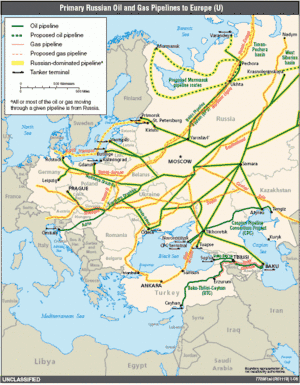
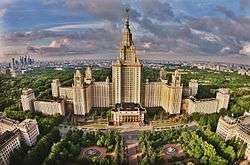
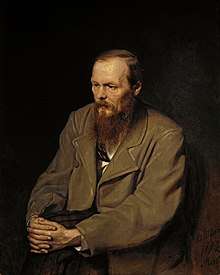
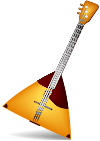
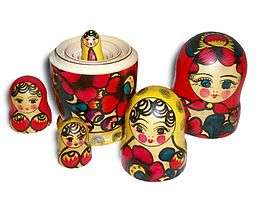

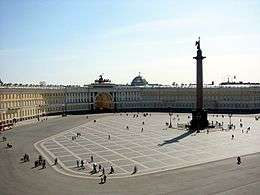



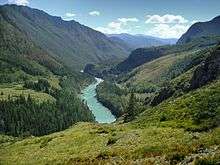

.svg.png)
.svg.png)
